Search Results for wip
Explore AI generated designs, images, art and prompts by top community artists and designers.
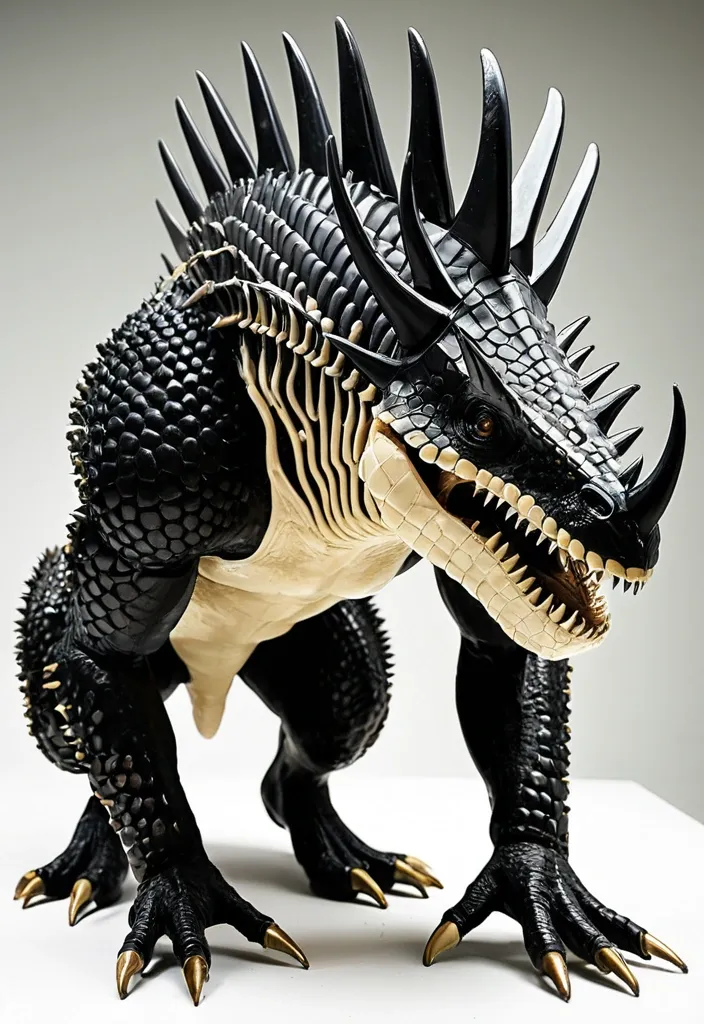
Physical Characteristics: Venenosus Regina is a titanic hybrid dinosaur standing approximately 20 feet tall at the shoulders and stretching 40 feet in length. Its frame is a powerful fusion of Tyrannosaurus rex and Giganotosaurus bulk , with a head shape that blends the robust cranial features of Giganotosaurus and the bony crown of Triceratops. The jawline is adorned with formidable bony spikes on each side , reminiscent of Triceratops horns , enhancing both offense and defense. Its body is armored with large , jet-black , glossy keratin scales inherited from Giant Pangolin DNA , interspersed with cream-colored underbelly patches. These scales are embedded with chromatophore cells from cuttlefish DNA , allowing Venenosus Regina to rapidly alter its skin color , texture , and pattern for camouflage or intimidation. The overall silhouette is muscular , lean and agile , with reduced hind legs that enable knuckle-walking , a trait borrowed from chimpanzee DNA , granting it a unique locomotion style that balances speed and stability.The forelimbs are robust and highly dexterous , equipped with slashing hook claws inspired by Saurophaganax and chimpanzee genetics , capable of delivering devastating swipes and manipulating tools or prey with precision. ,
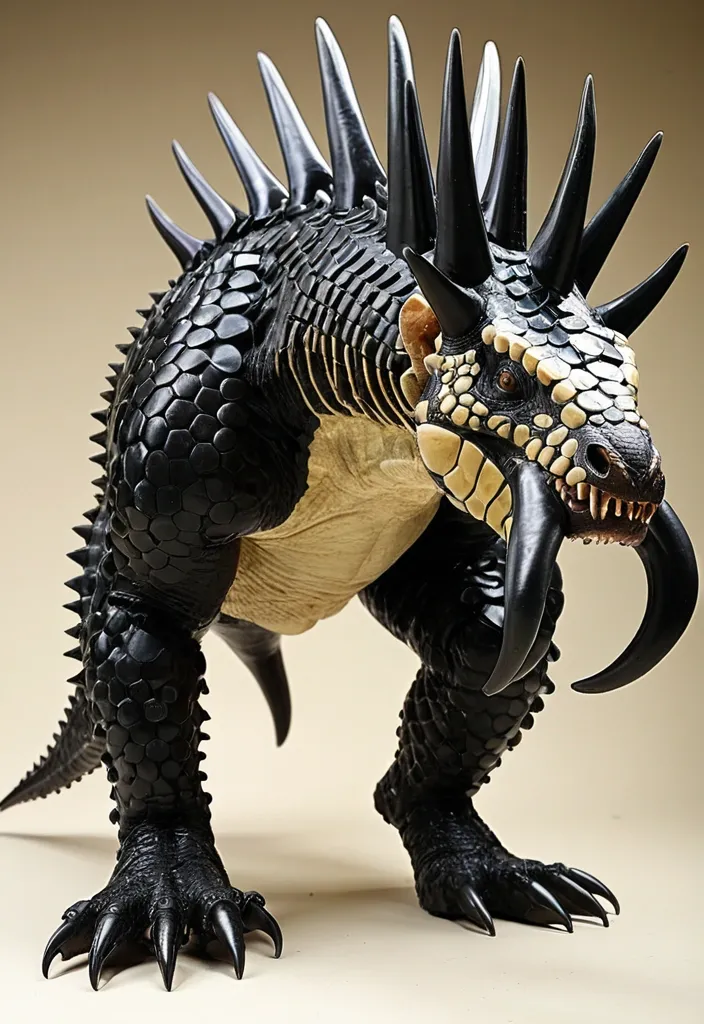
Physical Characteristics: Venenosus Regina is a titanic hybrid dinosaur standing approximately 20 feet tall at the shoulders and stretching 40 feet in length. Its frame is a powerful fusion of Tyrannosaurus rex and Giganotosaurus bulk , with a head shape that blends the robust cranial features of Giganotosaurus and the bony crown of Triceratops. The jawline is adorned with formidable bony spikes on each side , reminiscent of Triceratops horns , enhancing both offense and defense. Its body is armored with large , jet-black , glossy keratin scales inherited from Giant Pangolin DNA , interspersed with cream-colored underbelly patches. These scales are embedded with chromatophore cells from cuttlefish DNA , allowing Venenosus Regina to rapidly alter its skin color , texture , and pattern for camouflage or intimidation. The overall silhouette is muscular , lean and agile , with reduced hind legs that enable knuckle-walking , a trait borrowed from chimpanzee DNA , granting it a unique locomotion style that balances speed and stability.The forelimbs are robust and highly dexterous , equipped with slashing hook claws inspired by Saurophaganax and chimpanzee genetics , capable of delivering devastating swipes and manipulating tools or prey with precision. ,
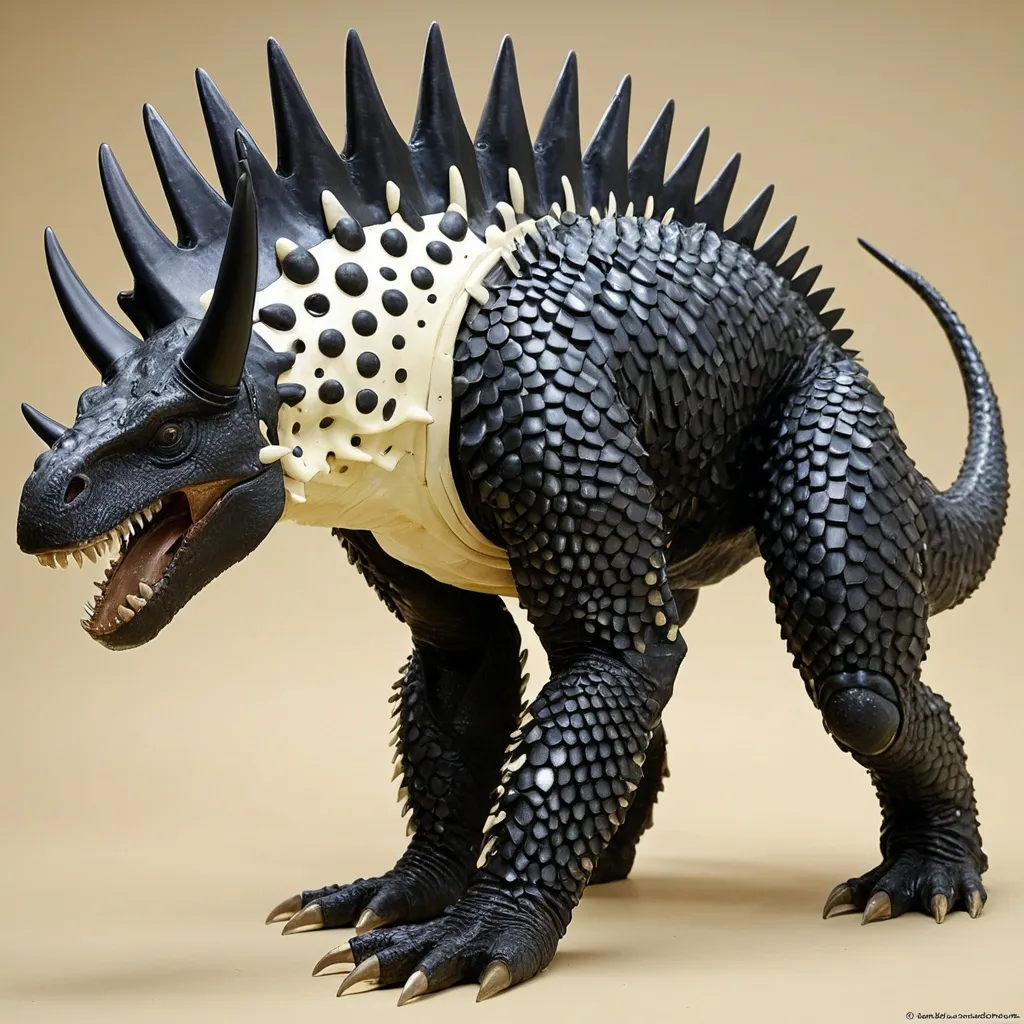
Physical Characteristics: Venenosus Regina is a titanic hybrid dinosaur standing approximately 20 feet tall at the shoulders and stretching 40 feet in length. Its frame is a powerful fusion of Tyrannosaurus rex and Giganotosaurus bulk , with a head shape that blends the robust cranial features of Giganotosaurus and the bony crown of Triceratops. The jawline is adorned with formidable bony spikes on each side , reminiscent of Triceratops horns , enhancing both offense and defense. Its body is armored with large , jet-black , glossy keratin scales inherited from Giant Pangolin DNA , interspersed with cream-colored underbelly patches. These scales are embedded with chromatophore cells from cuttlefish DNA , allowing Venenosus Regina to rapidly alter its skin color , texture , and pattern for camouflage or intimidation. The overall silhouette is muscular , lean and agile , with reduced hind legs that enable knuckle-walking , a trait borrowed from chimpanzee DNA , granting it a unique locomotion style that balances speed and stability.The forelimbs are robust and highly dexterous , equipped with slashing hook claws inspired by Saurophaganax and chimpanzee genetics , capable of delivering devastating swipes and manipulating tools or prey with precision. ,
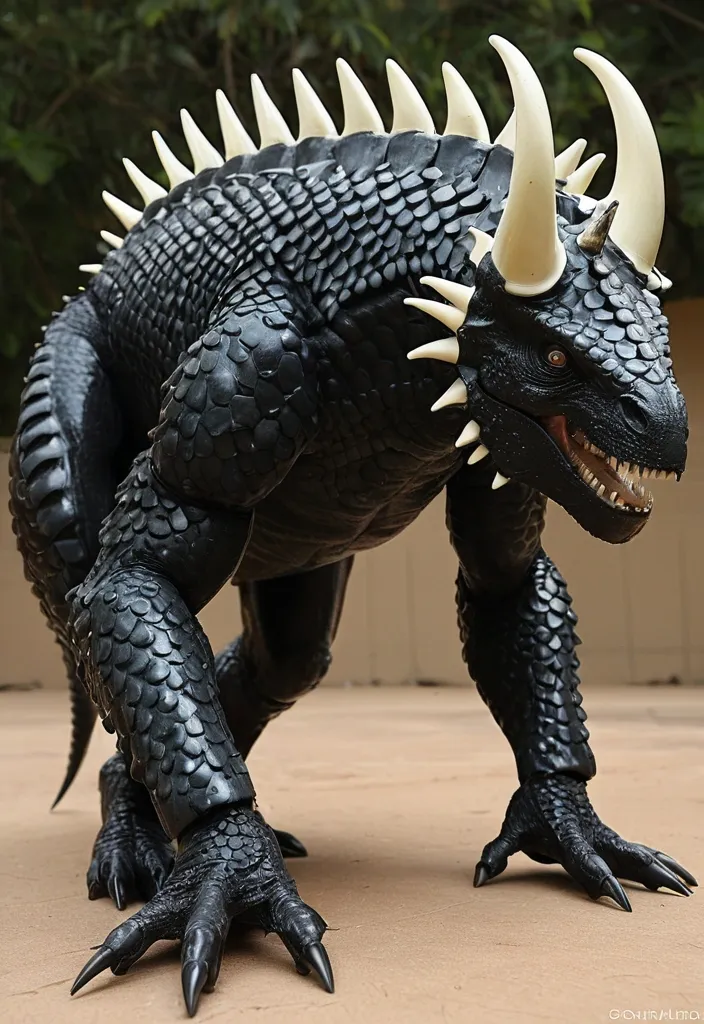
Physical Characteristics: Venenosus Regina is a titanic hybrid dinosaur standing approximately 20 feet tall at the shoulders and stretching 40 feet in length. Its frame is a powerful fusion of Tyrannosaurus rex and Giganotosaurus bulk , with a head shape that blends the robust cranial features of Giganotosaurus and the bony crown of Triceratops. The jawline is adorned with formidable bony spikes on each side , reminiscent of Triceratops horns , enhancing both offense and defense. Its body is armored with large , jet-black , glossy keratin scales inherited from Giant Pangolin DNA , interspersed with cream-colored underbelly patches. These scales are embedded with chromatophore cells from cuttlefish DNA , allowing Venenosus Regina to rapidly alter its skin color , texture , and pattern for camouflage or intimidation. The overall silhouette is muscular , lean and agile , with reduced hind legs that enable knuckle-walking , a trait borrowed from chimpanzee DNA , granting it a unique locomotion style that balances speed and stability.The forelimbs are robust and highly dexterous , equipped with slashing hook claws inspired by Saurophaganax and chimpanzee genetics , capable of delivering devastating swipes and manipulating tools or prey with precision. ,
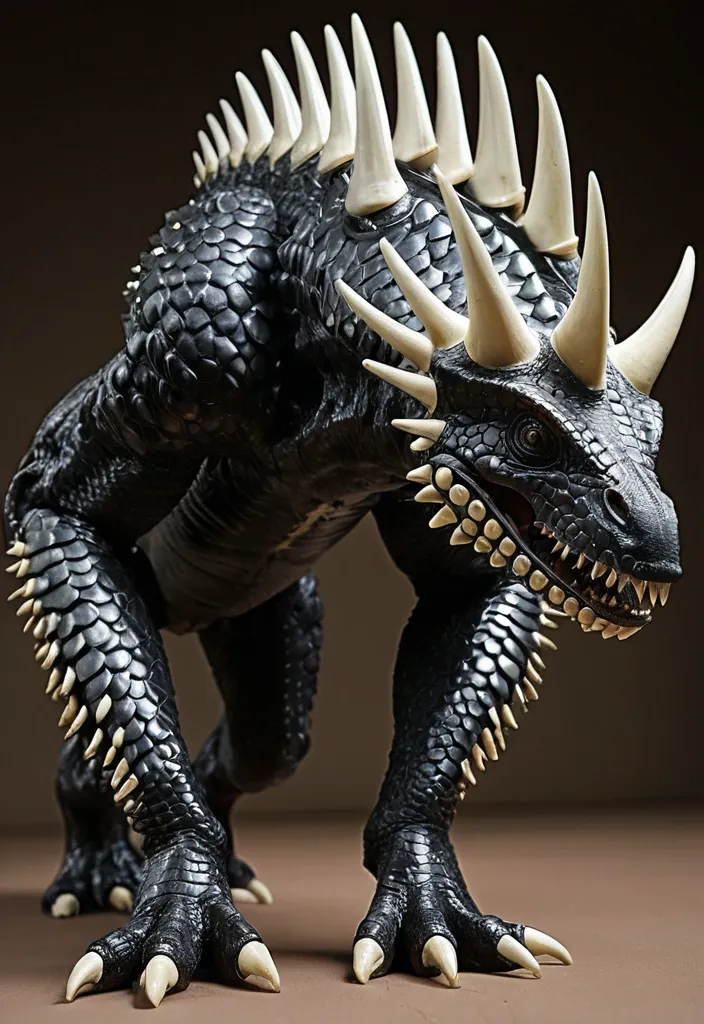
Physical Characteristics: Venenosus Regina is a titanic hybrid dinosaur standing approximately 20 feet tall at the shoulders and stretching 40 feet in length. Its frame is a powerful fusion of Tyrannosaurus rex and Giganotosaurus bulk , with a head shape that blends the robust cranial features of Giganotosaurus and the bony crown of Triceratops. The jawline is adorned with formidable bony spikes on each side , reminiscent of Triceratops horns , enhancing both offense and defense. Its body is armored with large , jet-black , glossy keratin scales inherited from Giant Pangolin DNA , interspersed with cream-colored underbelly patches. These scales are embedded with chromatophore cells from cuttlefish DNA , allowing Venenosus Regina to rapidly alter its skin color , texture , and pattern for camouflage or intimidation. The overall silhouette is muscular , lean and agile , with reduced hind legs that enable knuckle-walking , a trait borrowed from chimpanzee DNA , granting it a unique locomotion style that balances speed and stability.The forelimbs are robust and highly dexterous , equipped with slashing hook claws inspired by Saurophaganax and chimpanzee genetics , capable of delivering devastating swipes and manipulating tools or prey with precision. ,

Physical Characteristics: Venenosus Regina is a titanic hybrid dinosaur standing approximately 20 feet tall at the shoulders and stretching 40 feet in length. Its frame is a powerful fusion of Tyrannosaurus rex and Giganotosaurus bulk , with a head shape that blends the robust cranial features of Giganotosaurus and the bony crown of Triceratops. The jawline is adorned with formidable bony spikes on each side , reminiscent of Triceratops horns , enhancing both offense and defense. Its body is armored with large , jet-black , glossy keratin scales inherited from Giant Pangolin DNA , interspersed with cream-colored underbelly patches. These scales are embedded with chromatophore cells from cuttlefish DNA , allowing Venenosus Regina to rapidly alter its skin color , texture , and pattern for camouflage or intimidation. The overall silhouette is muscular , lean and agile , with reduced hind legs that enable knuckle-walking , a trait borrowed from chimpanzee DNA , granting it a unique locomotion style that balances speed and stability.The forelimbs are robust and highly dexterous , equipped with slashing hook claws inspired by Saurophaganax and chimpanzee genetics , capable of delivering devastating swipes and manipulating tools or prey with precision. ,
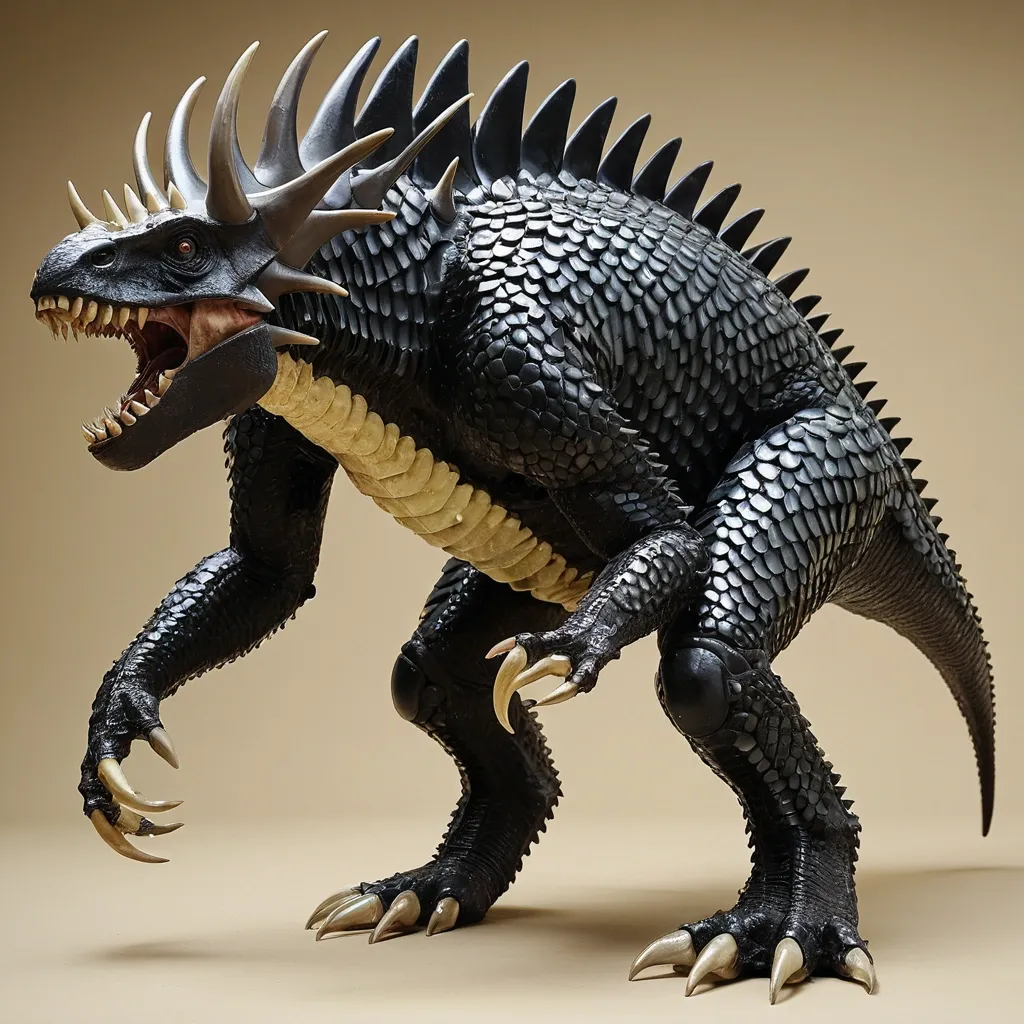
Physical Characteristics: Venenosus Regina is a titanic hybrid dinosaur standing approximately 20 feet tall at the shoulders and stretching 40 feet in length. Its frame is a powerful fusion of Tyrannosaurus rex and Giganotosaurus bulk , with a head shape that blends the robust cranial features of Giganotosaurus and the bony crown of Triceratops. The jawline is adorned with formidable bony spikes on each side , reminiscent of Triceratops horns , enhancing both offense and defense. Its body is armored with large , jet-black , glossy keratin scales inherited from Giant Pangolin DNA , interspersed with cream-colored underbelly patches. These scales are embedded with chromatophore cells from cuttlefish DNA , allowing Venenosus Regina to rapidly alter its skin color , texture , and pattern for camouflage or intimidation. The overall silhouette is muscular , lean and agile , with reduced hind legs that enable knuckle-walking , a trait borrowed from chimpanzee DNA , granting it a unique locomotion style that balances speed and stability.The forelimbs are robust and highly dexterous , equipped with slashing hook claws inspired by Saurophaganax and chimpanzee genetics , capable of delivering devastating swipes and manipulating tools or prey with precision. ,
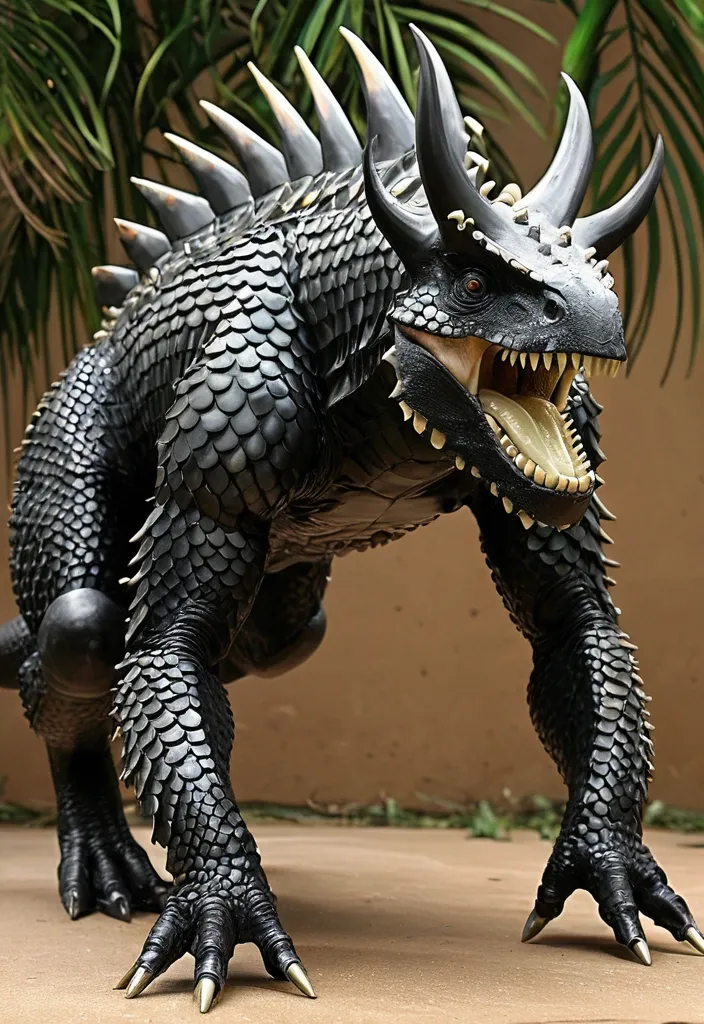
Physical Characteristics: Venenosus Regina is a titanic hybrid dinosaur standing approximately 20 feet tall at the shoulders and stretching 40 feet in length. Its frame is a powerful fusion of Tyrannosaurus rex and Giganotosaurus bulk , with a head shape that blends the robust cranial features of Giganotosaurus and the bony crown of Triceratops. The jawline is adorned with formidable bony spikes on each side , reminiscent of Triceratops horns , enhancing both offense and defense. Its body is armored with large , jet-black , glossy keratin scales inherited from Giant Pangolin DNA , interspersed with cream-colored underbelly patches. These scales are embedded with chromatophore cells from cuttlefish DNA , allowing Venenosus Regina to rapidly alter its skin color , texture , and pattern for camouflage or intimidation. The overall silhouette is muscular , lean and agile , with reduced hind legs that enable knuckle-walking , a trait borrowed from chimpanzee DNA , granting it a unique locomotion style that balances speed and stability.The forelimbs are robust and highly dexterous , equipped with slashing hook claws inspired by Saurophaganax and chimpanzee genetics , capable of delivering devastating swipes and manipulating tools or prey with precision. ,
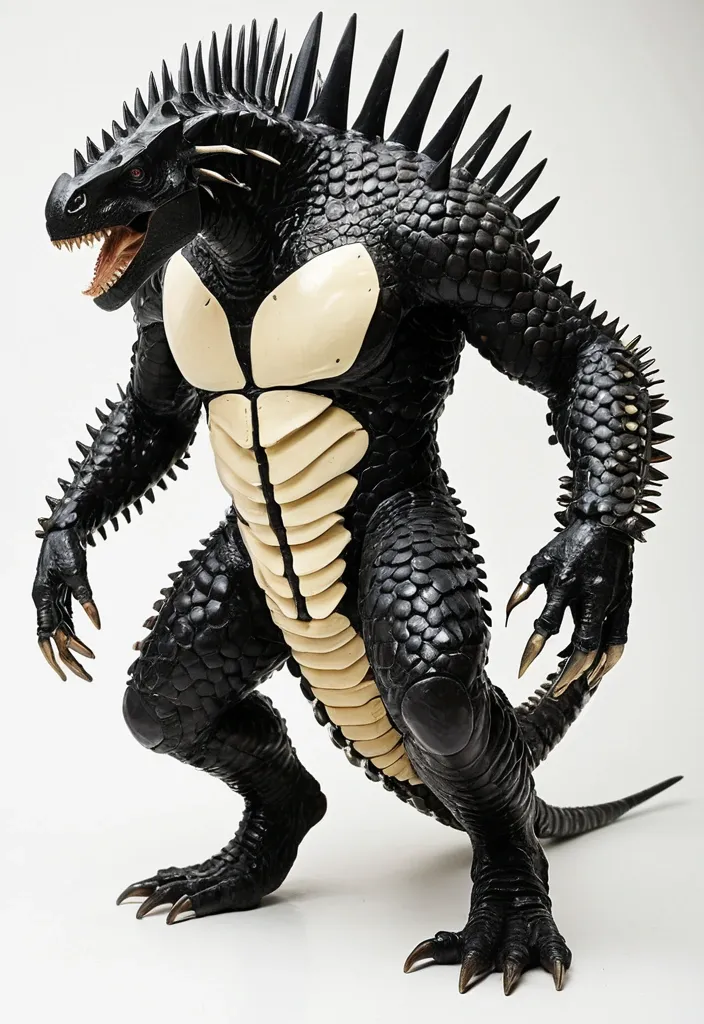
Physical Characteristics: Venenosus Regina is a titanic hybrid dinosaur standing approximately 20 feet tall at the shoulders and stretching 40 feet in length. Its frame is a powerful fusion of Tyrannosaurus rex and Giganotosaurus bulk , with a head shape that blends the robust cranial features of Giganotosaurus and the bony crown of Triceratops. The jawline is adorned with formidable bony spikes on each side , reminiscent of Triceratops horns , enhancing both offense and defense. Its body is armored with large , jet-black , glossy keratin scales inherited from Giant Pangolin DNA , interspersed with cream-colored underbelly patches. These scales are embedded with chromatophore cells from cuttlefish DNA , allowing Venenosus Regina to rapidly alter its skin color , texture , and pattern for camouflage or intimidation. The overall silhouette is muscular , lean and agile , with reduced hind legs that enable knuckle-walking , a trait borrowed from chimpanzee DNA , granting it a unique locomotion style that balances speed and stability.The forelimbs are robust and highly dexterous , equipped with slashing hook claws inspired by Saurophaganax and chimpanzee genetics , capable of delivering devastating swipes and manipulating tools or prey with precision. ,
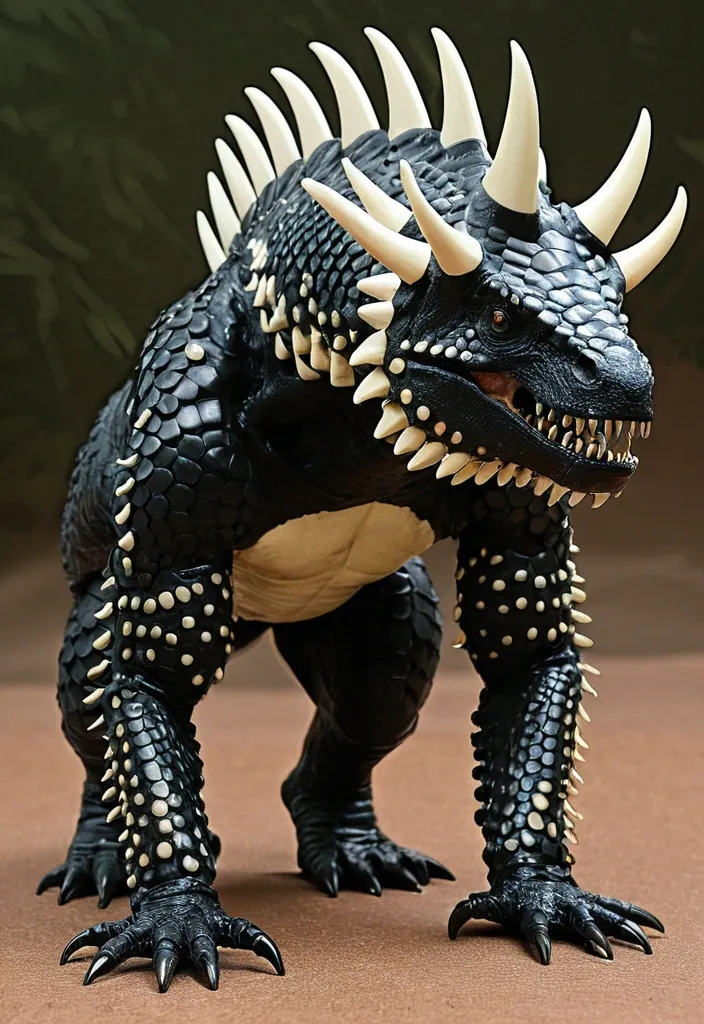
Physical Characteristics: Venenosus Regina is a titanic hybrid dinosaur standing approximately 20 feet tall at the shoulders and stretching 40 feet in length. Its frame is a powerful fusion of Tyrannosaurus rex and Giganotosaurus bulk , with a head shape that blends the robust cranial features of Giganotosaurus and the bony crown of Triceratops. The jawline is adorned with formidable bony spikes on each side , reminiscent of Triceratops horns , enhancing both offense and defense. Its body is armored with large , jet-black , glossy keratin scales inherited from Giant Pangolin DNA , interspersed with cream-colored underbelly patches. These scales are embedded with chromatophore cells from cuttlefish DNA , allowing Venenosus Regina to rapidly alter its skin color , texture , and pattern for camouflage or intimidation. The overall silhouette is muscular , lean and agile , with reduced hind legs that enable knuckle-walking , a trait borrowed from chimpanzee DNA , granting it a unique locomotion style that balances speed and stability.The forelimbs are robust and highly dexterous , equipped with slashing hook claws inspired by Saurophaganax and chimpanzee genetics , capable of delivering devastating swipes and manipulating tools or prey with precision. ,
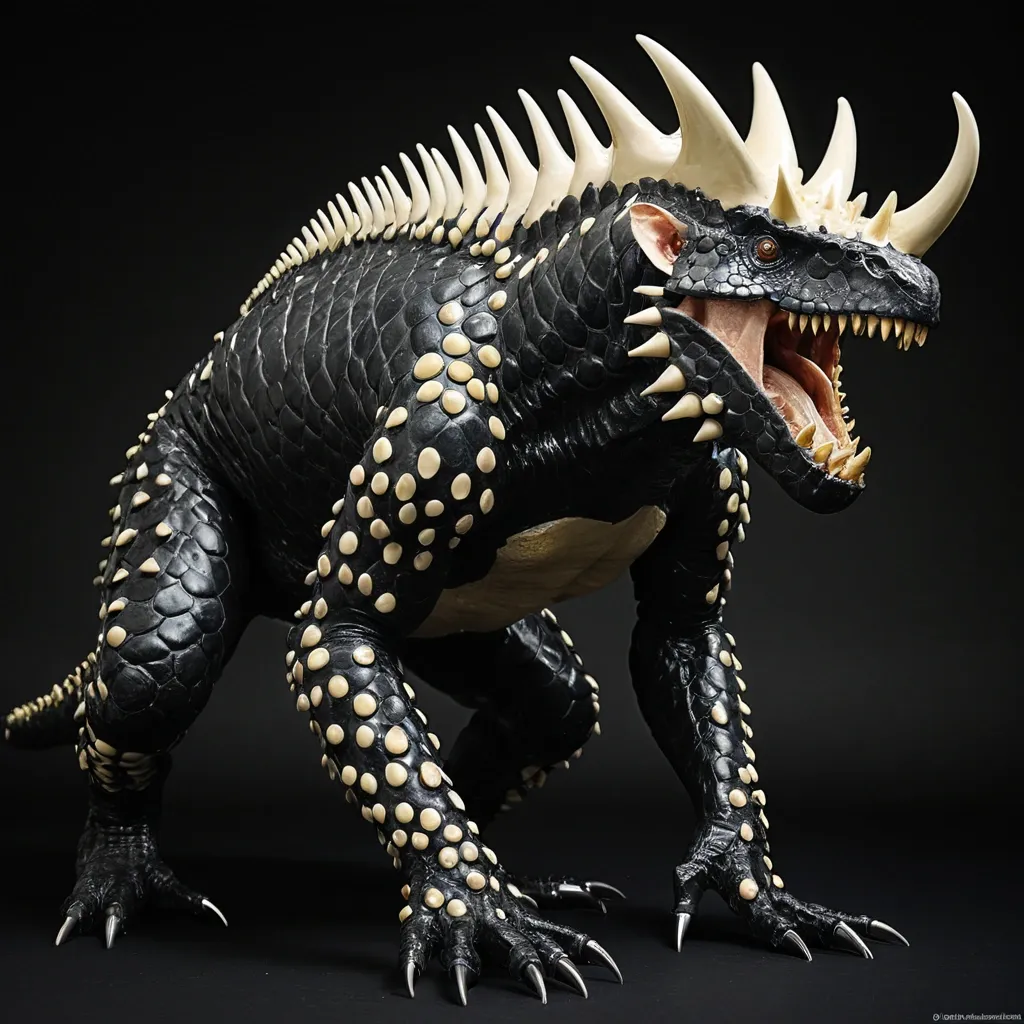
Physical Characteristics: Venenosus Regina is a titanic hybrid dinosaur standing approximately 20 feet tall at the shoulders and stretching 40 feet in length. Its frame is a powerful fusion of Tyrannosaurus rex and Giganotosaurus bulk , with a head shape that blends the robust cranial features of Giganotosaurus and the bony crown of Triceratops. The jawline is adorned with formidable bony spikes on each side , reminiscent of Triceratops horns , enhancing both offense and defense. Its body is armored with large , jet-black , glossy keratin scales inherited from Giant Pangolin DNA , interspersed with cream-colored underbelly patches. These scales are embedded with chromatophore cells from cuttlefish DNA , allowing Venenosus Regina to rapidly alter its skin color , texture , and pattern for camouflage or intimidation. The overall silhouette is muscular , lean and agile , with reduced hind legs that enable knuckle-walking , a trait borrowed from chimpanzee DNA , granting it a unique locomotion style that balances speed and stability.The forelimbs are robust and highly dexterous , equipped with slashing hook claws inspired by Saurophaganax and chimpanzee genetics , capable of delivering devastating swipes and manipulating tools or prey with precision. ,
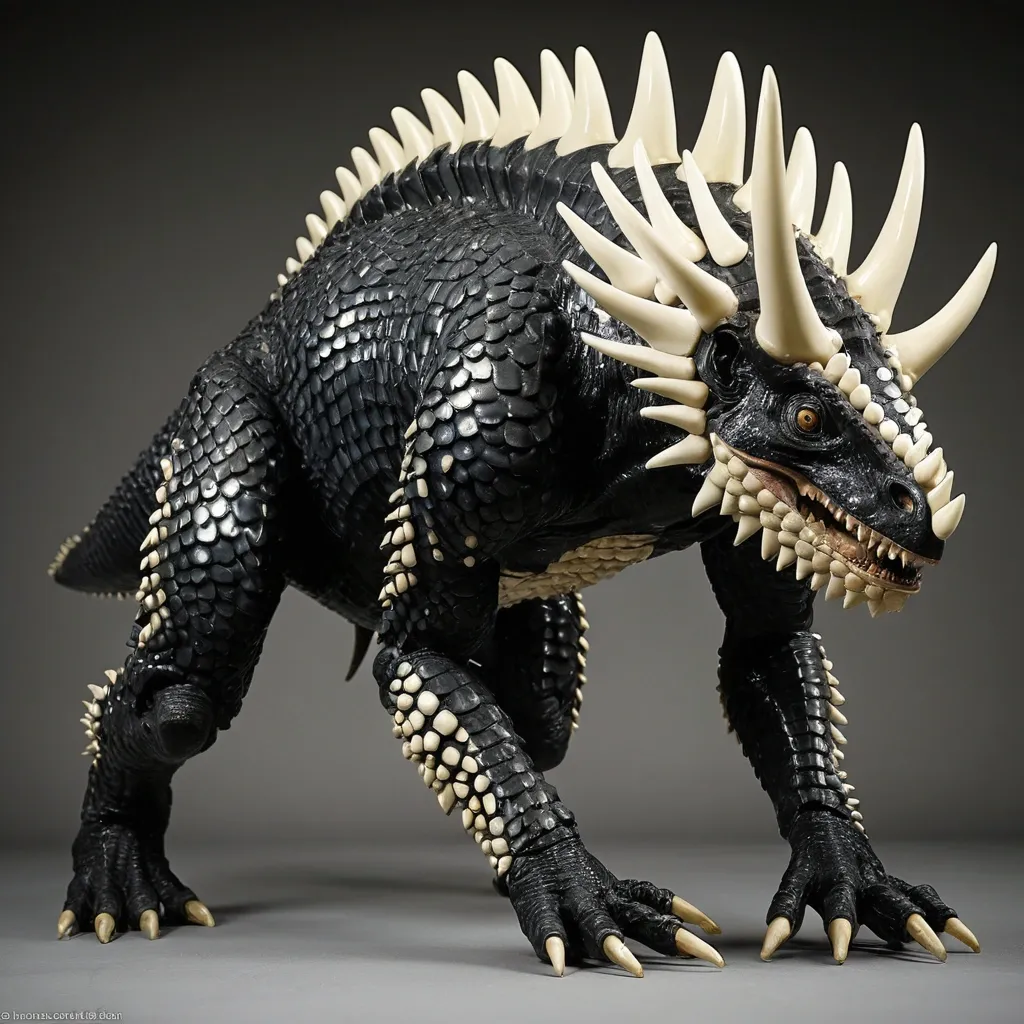
Physical Characteristics: Venenosus Regina is a titanic hybrid dinosaur standing approximately 20 feet tall at the shoulders and stretching 40 feet in length. Its frame is a powerful fusion of Tyrannosaurus rex and Giganotosaurus bulk , with a head shape that blends the robust cranial features of Giganotosaurus and the bony crown of Triceratops. The jawline is adorned with formidable bony spikes on each side , reminiscent of Triceratops horns , enhancing both offense and defense. Its body is armored with large , jet-black , glossy keratin scales inherited from Giant Pangolin DNA , interspersed with cream-colored underbelly patches. These scales are embedded with chromatophore cells from cuttlefish DNA , allowing Venenosus Regina to rapidly alter its skin color , texture , and pattern for camouflage or intimidation. The overall silhouette is muscular , lean and agile , with reduced hind legs that enable knuckle-walking , a trait borrowed from chimpanzee DNA , granting it a unique locomotion style that balances speed and stability.The forelimbs are robust and highly dexterous , equipped with slashing hook claws inspired by Saurophaganax and chimpanzee genetics , capable of delivering devastating swipes and manipulating tools or prey with precision. ,
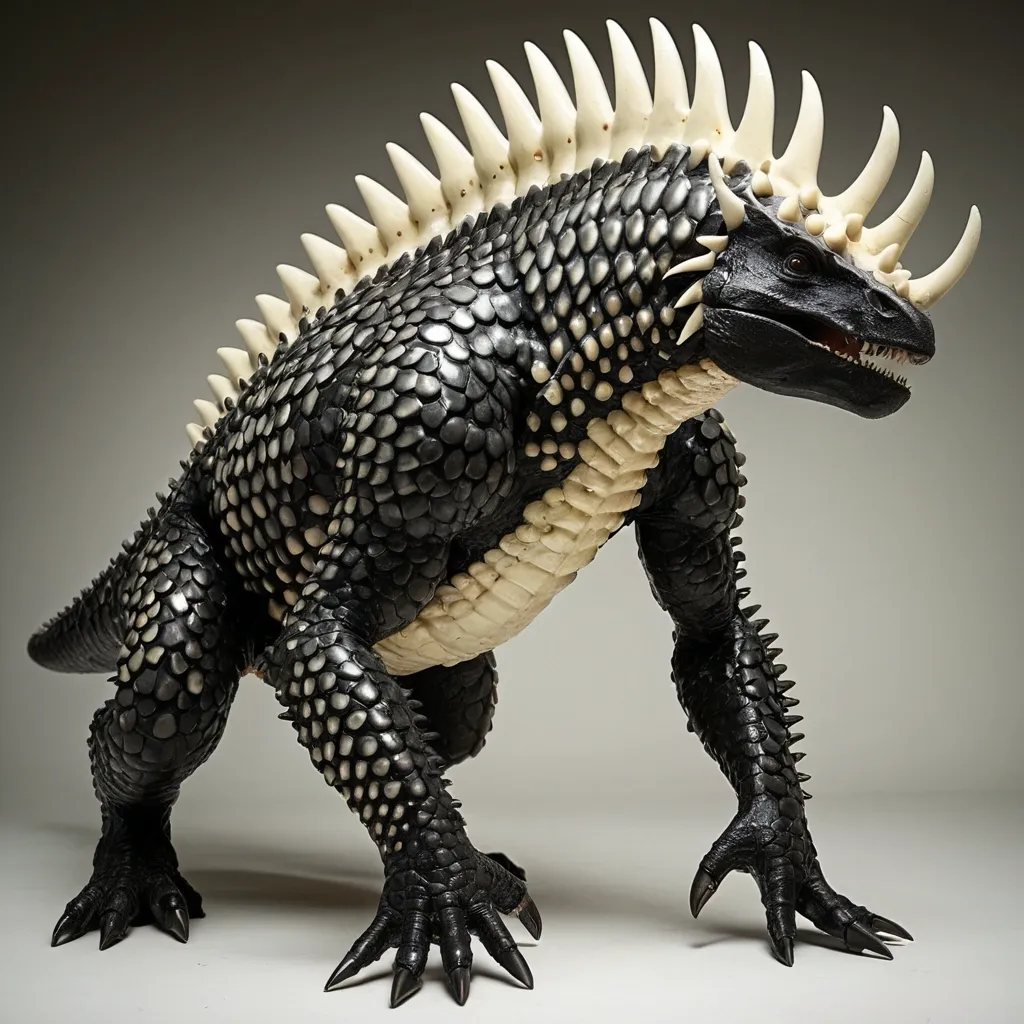
Physical Characteristics: Venenosus Regina is a titanic hybrid dinosaur standing approximately 20 feet tall at the shoulders and stretching 40 feet in length. Its frame is a powerful fusion of Tyrannosaurus rex and Giganotosaurus bulk , with a head shape that blends the robust cranial features of Giganotosaurus and the bony crown of Triceratops. The jawline is adorned with formidable bony spikes on each side , reminiscent of Triceratops horns , enhancing both offense and defense. Its body is armored with large , jet-black , glossy keratin scales inherited from Giant Pangolin DNA , interspersed with cream-colored underbelly patches. These scales are embedded with chromatophore cells from cuttlefish DNA , allowing Venenosus Regina to rapidly alter its skin color , texture , and pattern for camouflage or intimidation. The overall silhouette is muscular , lean and agile , with reduced hind legs that enable knuckle-walking , a trait borrowed from chimpanzee DNA , granting it a unique locomotion style that balances speed and stability.The forelimbs are robust and highly dexterous , equipped with slashing hook claws inspired by Saurophaganax and chimpanzee genetics , capable of delivering devastating swipes and manipulating tools or prey with precision. ,
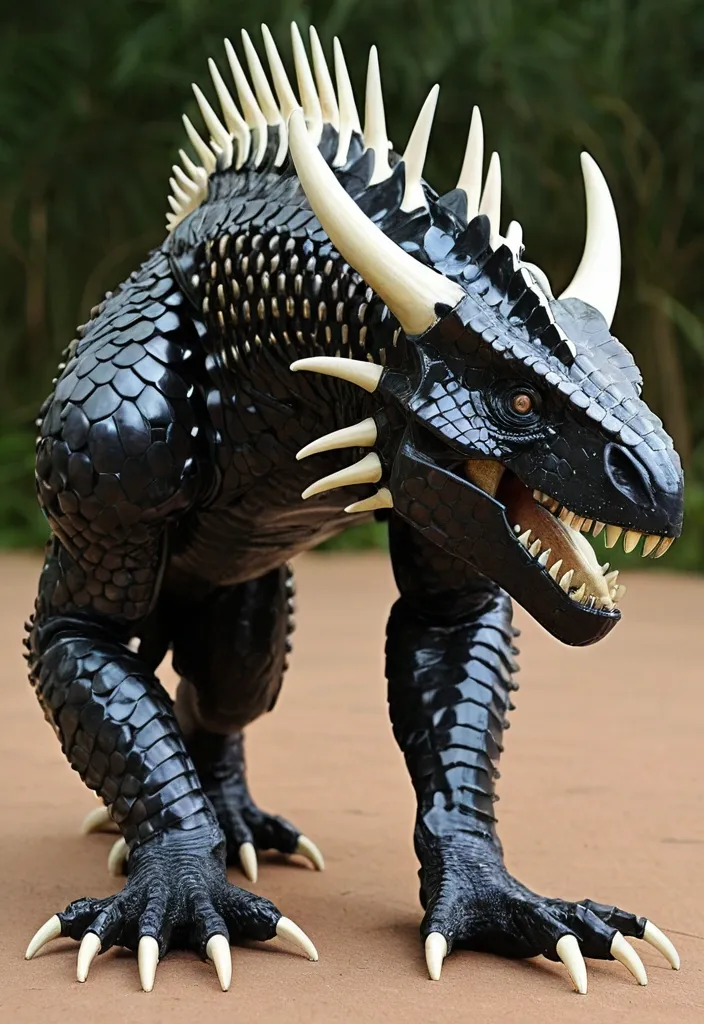
Physical Characteristics:Venenosus Regina is a titanic hybrid dinosaur standing approximately 20 feet tall at the shoulders and stretching 40 feet in length. Its frame is a powerful fusion of Tyrannosaurus rex and Giganotosaurus bulk , with a head shape that blends the robust cranial features of Giganotosaurus and the bony crown of Triceratops. The jawline is adorned with formidable bony spikes on each side , reminiscent of Triceratops horns , enhancing both offense and defense.Its body is armored with large , jet-black , glossy keratin scales inherited from Giant Pangolin DNA , interspersed with cream-colored underbelly patches. These scales are embedded with chromatophore cells from cuttlefish DNA , allowing Venenosus Regina to rapidly alter its skin color , texture , and pattern for camouflage or intimidation. The overall silhouette is muscular and agile , with reduced hind legs that enable knuckle-walking , a trait borrowed from chimpanzee DNA , granting it a unique locomotion style that balances speed and stability.The forelimbs are robust and highly dexterous , equipped with slashing hook claws inspired by Saurophaganax and chimpanzee genetics , capable of delivering devastating swipes and manipulating tools or prey with precision. ,
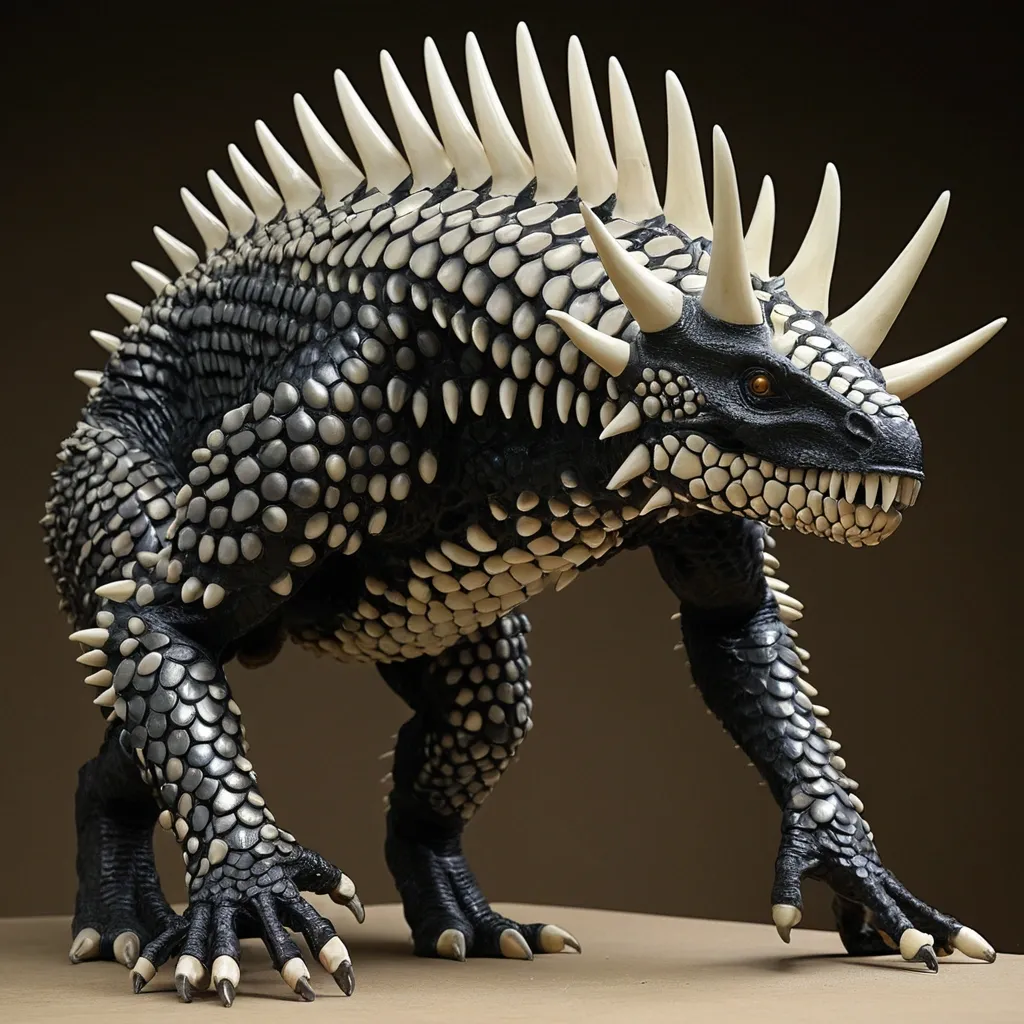
Physical Characteristics:Venenosus Regina is a titanic hybrid dinosaur standing approximately 20 feet tall at the shoulders and stretching 40 feet in length. Its frame is a powerful fusion of Tyrannosaurus rex and Giganotosaurus bulk , with a head shape that blends the robust cranial features of Giganotosaurus and the bony crown of Triceratops. The jawline is adorned with formidable bony spikes on each side , reminiscent of Triceratops horns , enhancing both offense and defense.Its body is armored with large , jet-black , glossy keratin scales inherited from Giant Pangolin DNA , interspersed with cream-colored underbelly patches. These scales are embedded with chromatophore cells from cuttlefish DNA , allowing Venenosus Regina to rapidly alter its skin color , texture , and pattern for camouflage or intimidation. The overall silhouette is muscular and agile , with reduced hind legs that enable knuckle-walking , a trait borrowed from chimpanzee DNA , granting it a unique locomotion style that balances speed and stability.The forelimbs are robust and highly dexterous , equipped with slashing hook claws inspired by Saurophaganax and chimpanzee genetics , capable of delivering devastating swipes and manipulating tools or prey with precision. ,
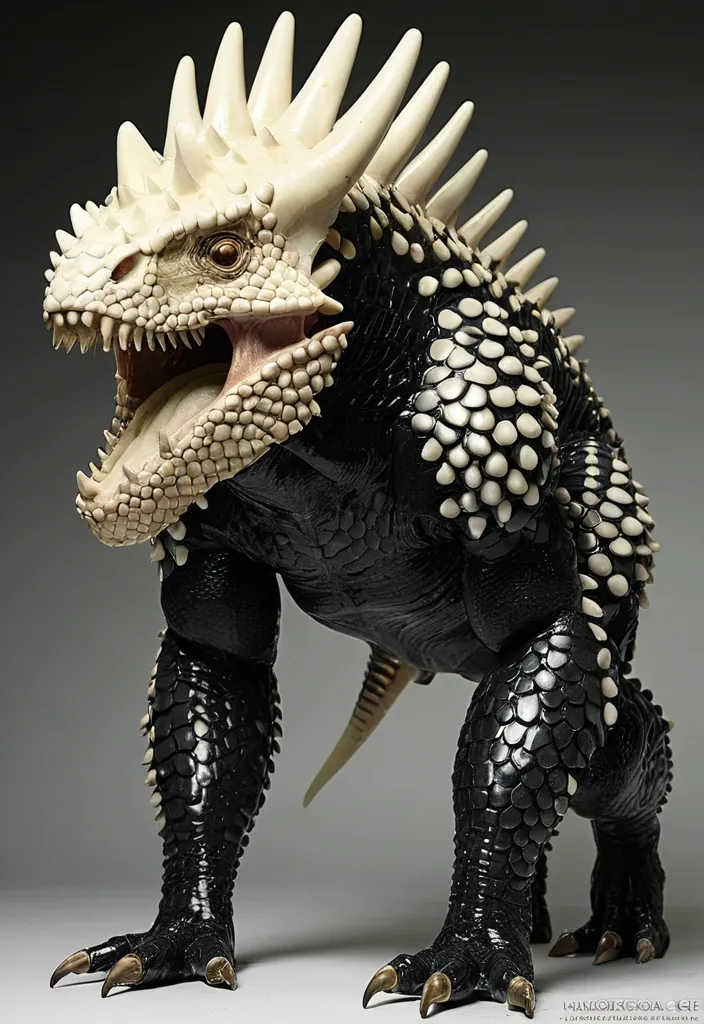
Physical Characteristics:Venenosus Regina is a titanic hybrid dinosaur standing approximately 20 feet tall at the shoulders and stretching 40 feet in length. Its frame is a powerful fusion of Tyrannosaurus rex and Giganotosaurus bulk , with a head shape that blends the robust cranial features of Giganotosaurus and the bony crown of Triceratops. The jawline is adorned with formidable bony spikes on each side , reminiscent of Triceratops horns , enhancing both offense and defense.Its body is armored with large , jet-black , glossy keratin scales inherited from Giant Pangolin DNA , interspersed with cream-colored underbelly patches. These scales are embedded with chromatophore cells from cuttlefish DNA , allowing Venenosus Regina to rapidly alter its skin color , texture , and pattern for camouflage or intimidation. The overall silhouette is muscular and agile , with reduced hind legs that enable knuckle-walking , a trait borrowed from chimpanzee DNA , granting it a unique locomotion style that balances speed and stability.The forelimbs are robust and highly dexterous , equipped with slashing hook claws inspired by Saurophaganax and chimpanzee genetics , capable of delivering devastating swipes and manipulating tools or prey with precision. ,
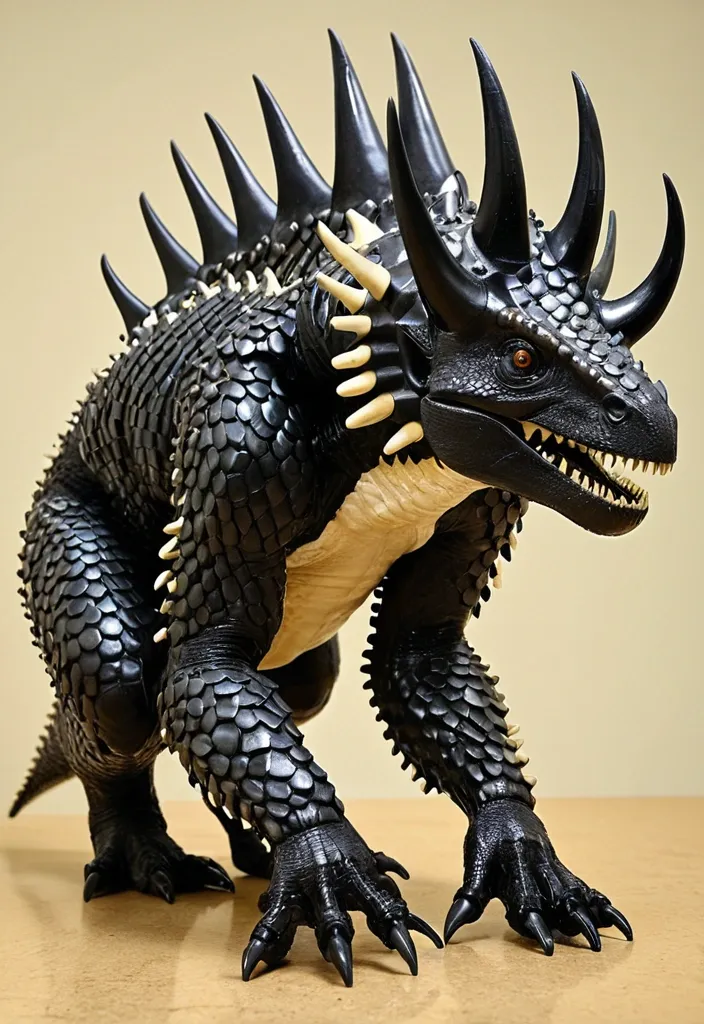
Physical Characteristics:Venenosus Regina is a titanic hybrid dinosaur standing approximately 20 feet tall at the shoulders and stretching 40 feet in length. Its frame is a powerful fusion of Tyrannosaurus rex and Giganotosaurus bulk , with a head shape that blends the robust cranial features of Giganotosaurus and the bony crown of Triceratops. The jawline is adorned with formidable bony spikes on each side , reminiscent of Triceratops horns , enhancing both offense and defense.Its body is armored with large , jet-black , glossy keratin scales inherited from Giant Pangolin DNA , interspersed with cream-colored underbelly patches. These scales are embedded with chromatophore cells from cuttlefish DNA , allowing Venenosus Regina to rapidly alter its skin color , texture , and pattern for camouflage or intimidation. The overall silhouette is muscular and agile , with reduced hind legs that enable knuckle-walking , a trait borrowed from chimpanzee DNA , granting it a unique locomotion style that balances speed and stability.The forelimbs are robust and highly dexterous , equipped with slashing hook claws inspired by Saurophaganax and chimpanzee genetics , capable of delivering devastating swipes and manipulating tools or prey with precision. ,

Physical Characteristics:Venenosus Regina is a titanic hybrid dinosaur standing approximately 20 feet tall at the shoulders and stretching 40 feet in length. Its frame is a powerful fusion of Tyrannosaurus rex and Giganotosaurus bulk , with a head shape that blends the robust cranial features of Giganotosaurus and the bony crown of Triceratops. The jawline is adorned with formidable bony spikes on each side , reminiscent of Triceratops horns , enhancing both offense and defense.Its body is armored with large , jet-black , glossy keratin scales inherited from Giant Pangolin DNA , interspersed with cream-colored underbelly patches. These scales are embedded with chromatophore cells from cuttlefish DNA , allowing Venenosus Regina to rapidly alter its skin color , texture , and pattern for camouflage or intimidation. The overall silhouette is muscular and agile , with reduced hind legs that enable knuckle-walking , a trait borrowed from chimpanzee DNA , granting it a unique locomotion style that balances speed and stability.The forelimbs are robust and highly dexterous , equipped with slashing hook claws inspired by Saurophaganax and chimpanzee genetics , capable of delivering devastating swipes and manipulating tools or prey with precision. ,
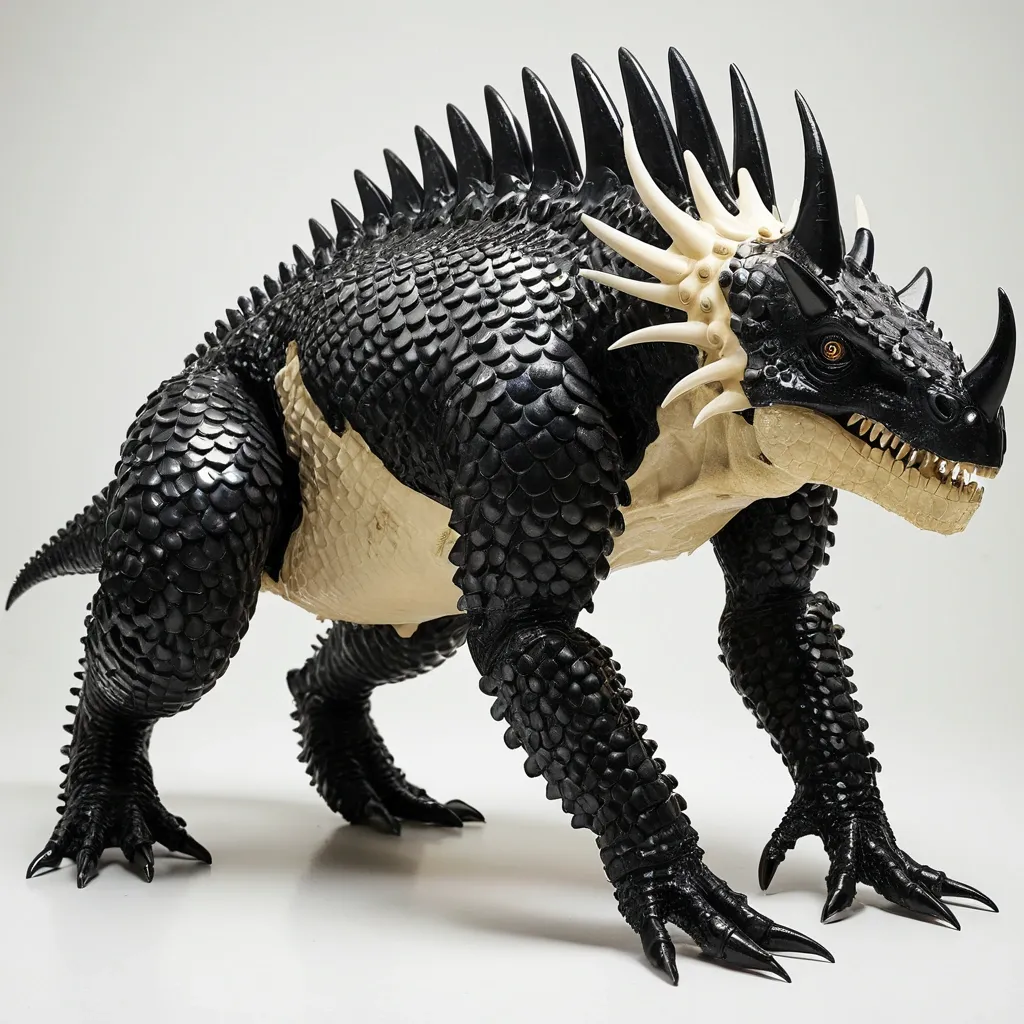
Physical Characteristics:Venenosus Regina is a titanic hybrid dinosaur standing approximately 20 feet tall at the shoulders and stretching 40 feet in length. Its frame is a powerful fusion of Tyrannosaurus rex and Giganotosaurus bulk , with a head shape that blends the robust cranial features of Giganotosaurus and the bony crown of Triceratops. The jawline is adorned with formidable bony spikes on each side , reminiscent of Triceratops horns , enhancing both offense and defense.Its body is armored with large , jet-black , glossy keratin scales inherited from Giant Pangolin DNA , interspersed with cream-colored underbelly patches. These scales are embedded with chromatophore cells from cuttlefish DNA , allowing Venenosus Regina to rapidly alter its skin color , texture , and pattern for camouflage or intimidation. The overall silhouette is muscular and agile , with reduced hind legs that enable knuckle-walking , a trait borrowed from chimpanzee DNA , granting it a unique locomotion style that balances speed and stability.The forelimbs are robust and highly dexterous , equipped with slashing hook claws inspired by Saurophaganax and chimpanzee genetics , capable of delivering devastating swipes and manipulating tools or prey with precision. ,
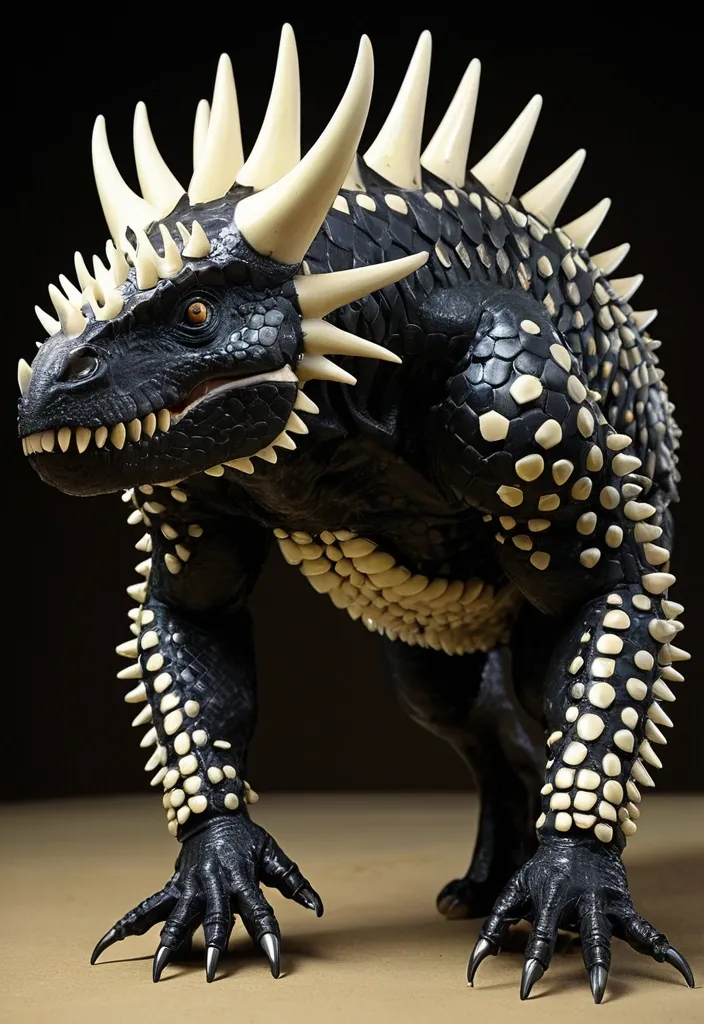
Physical Characteristics: Venenosus Regina is a titanic hybrid dinosaur standing approximately 20 feet tall at the shoulders and stretching 40 feet in length. Its frame is a powerful fusion of Tyrannosaurus rex and Giganotosaurus bulk , with a head shape that blends the robust cranial features of Giganotosaurus and the bony crown of Triceratops. The jawline is adorned with formidable bony spikes on each side , reminiscent of Triceratops horns , enhancing both offense and defense. Its body is armored with large , jet-black , glossy keratin scales inherited from Giant Pangolin DNA , interspersed with cream-colored underbelly patches. These scales are embedded with chromatophore cells from cuttlefish DNA , allowing Venenosus Regina to rapidly alter its skin color , texture , and pattern for camouflage or intimidation. The overall silhouette is muscular and agile , with reduced hind legs that enable knuckle-walking , a trait borrowed from chimpanzee DNA , granting it a unique locomotion style that balances speed and stability. The forelimbs are robust and highly dexterous , equipped with slashing hook claws inspired by Saurophaganax and chimpanzee genetics , capable of delivering devastating swipes and manipulating tools or prey with precision. ,
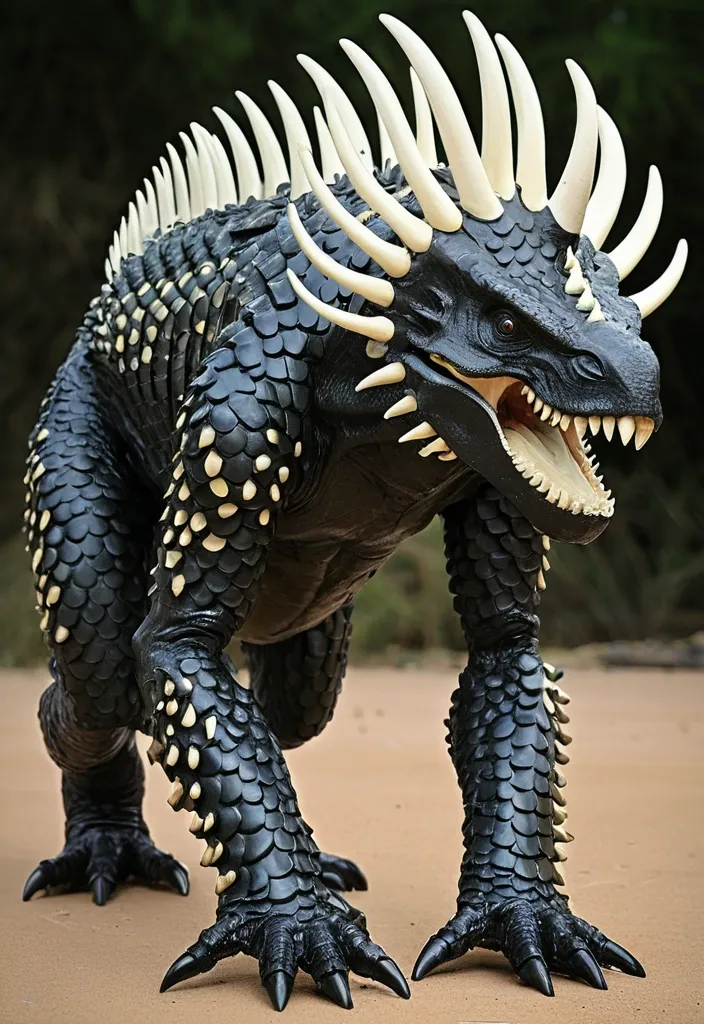
Physical Characteristics: Venenosus Regina is a titanic hybrid dinosaur standing approximately 20 feet tall at the shoulders and stretching 40 feet in length. Its frame is a powerful fusion of Tyrannosaurus rex and Giganotosaurus bulk , with a head shape that blends the robust cranial features of Giganotosaurus and the bony crown of Triceratops. The jawline is adorned with formidable bony spikes on each side , reminiscent of Triceratops horns , enhancing both offense and defense. Its body is armored with large , jet-black , glossy keratin scales inherited from Giant Pangolin DNA , interspersed with cream-colored underbelly patches. These scales are embedded with chromatophore cells from cuttlefish DNA , allowing Venenosus Regina to rapidly alter its skin color , texture , and pattern for camouflage or intimidation. The overall silhouette is muscular and agile , with reduced hind legs that enable knuckle-walking , a trait borrowed from chimpanzee DNA , granting it a unique locomotion style that balances speed and stability. The forelimbs are robust and highly dexterous , equipped with slashing hook claws inspired by Saurophaganax and chimpanzee genetics , capable of delivering devastating swipes and manipulating tools or prey with precision. ,
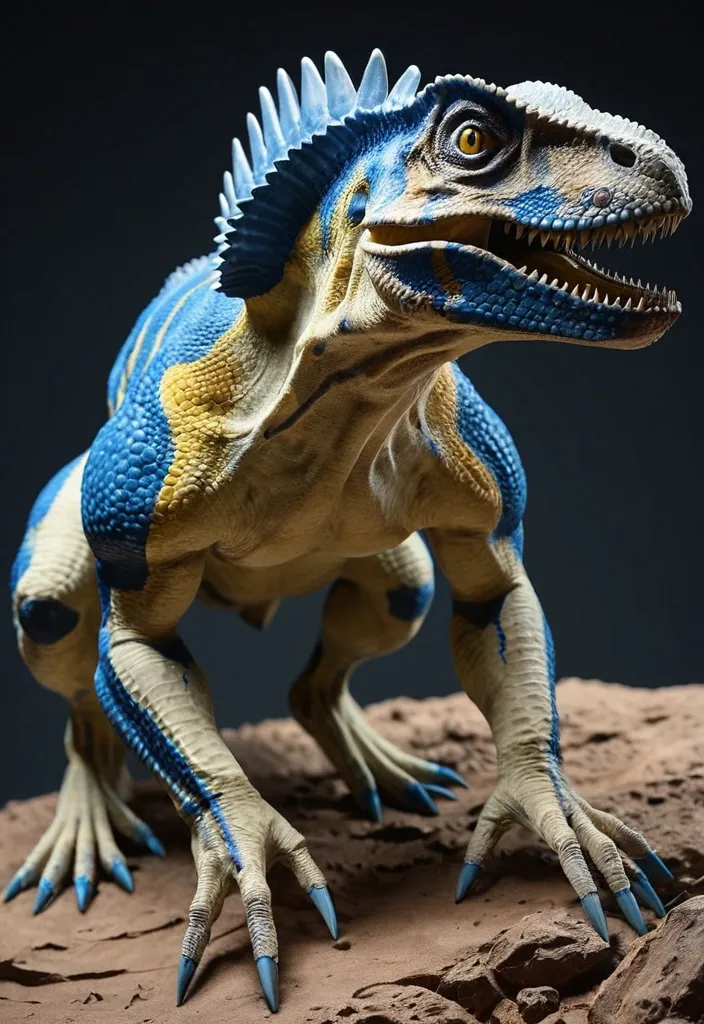
The hybrid was created by modifying the genome of a Tyrannosaurus rex , with the DNA of three other theropod species that were Utahraptor , Saurophaganax , and Giganotosaurus. Also the DNA of Quadrupes like Triceratops , and Scelidosaurus. DNA of modern animals such as Greater blue-ringed octopus , Inland Taipan , Northern Short-tailed Shrew , Komodo Dragon , Opossum , Mongoose , Gigantopithecus , Whiptail Lizard , Cuttlefish , and Tardigrades. The genome of Tyrannosaurus rex , Triceratops and Giganotosaurus was used as the base genome for the hybrid. Including the shape of the head in some parts from Giganotosaurus and Triceratops. Utahraptor DNA was added for high levels of intelligence and the ability to make plans , decisions and pack hunting. Reduced hind legs and Ape DNA added Knuckle-walking Quadruped. Triceratops , and Scelidosaurus were added to act as a biological form of armor that absorbed most of the incoming attacks. Northern short-tailed shrew , the Inland taipan's retractable fangs and the Komodo Dragon DNA was used to form the teeth of the Indominus that were used to tear through the flesh and armor of opponents. Saurophaganax and Gigantopithecus DNA added the presence of long strong arms with slashing hook claws and the use of tools. A swipe of the hybrid's claws would take down bigger opponents. While using tools for smaller elusive prey. Cuttlefish genes were intended to help the Venenosus withstand an accelerated growth , but it also added chromatophore cells in the skin so it could change the shape , color , and texture of its skin like a cuttlefish. Opossum , Mongoose and Tardigrades DNA was added for the Venenosus to be more resistant to climate changes , harmful toxins or bacterial infections , while tardigrades also added survival of extreme conditions such as exposure to extreme temperatures , extreme pressures , air deprivation , radiation , dehydration , and starvation. They have several defense mechanisms , including: A metabolic rate that gets as low as 0.01 percent of the normal rate. Organs protected by a sugary gel called trehalose. A protein that shields their DNA from radiation harm. Synthesis of cryoprotectant in chilly temperatures to prevent the development of ice crystals.Northern short-tailed shrew , the Inland Taipan , Greater blue-ringed octopus and the Komodo Dragon's DNA also added special cavities and glands in the skull that gave her infrared vision , and highly toxic saliva. Said DNA also gave her the ability to open her mandibles and jaws as wide as a snake , specifically at around 90 degrees.Lastly , DNA from a whiptail lizard was added for reproduction purposes. ,
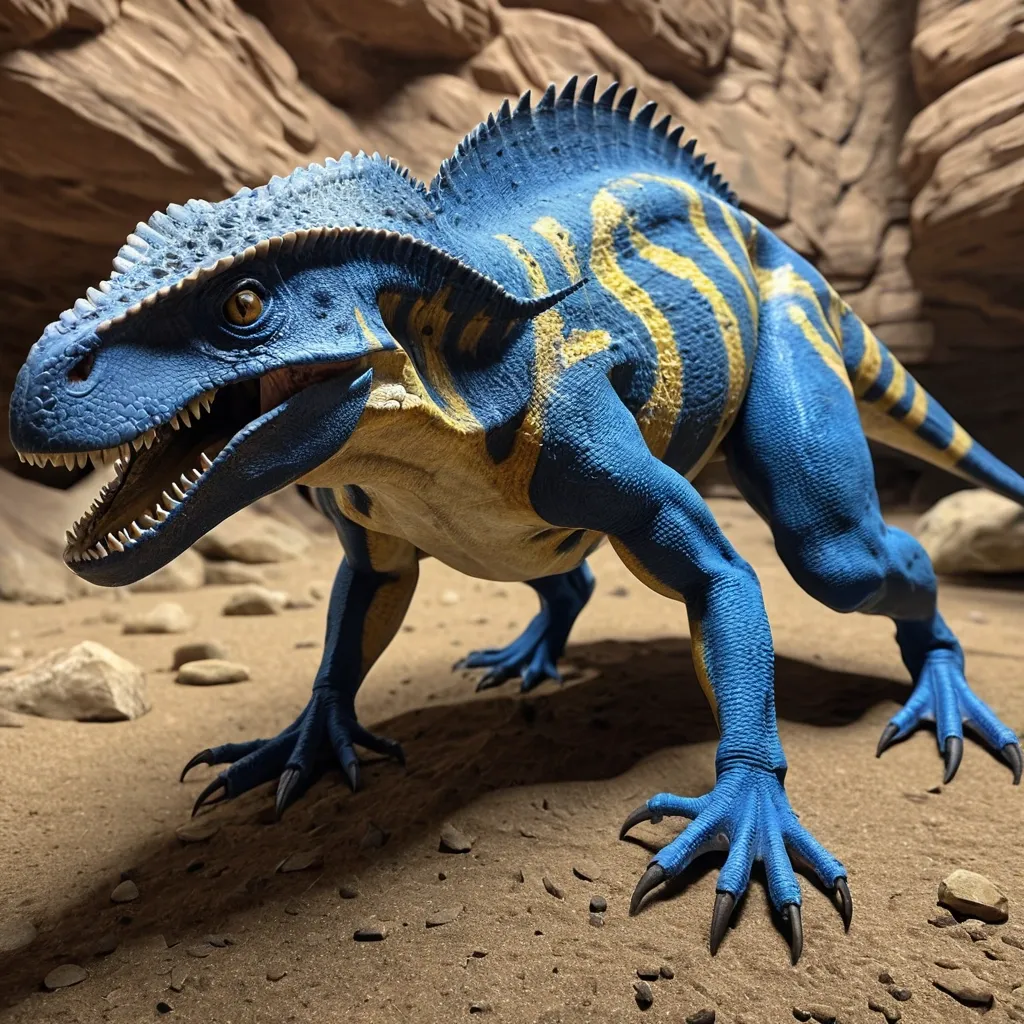
The hybrid was created by modifying the genome of a Tyrannosaurus rex , with the DNA of three other theropod species that were Utahraptor , Saurophaganax , and Giganotosaurus. Also the DNA of Quadrupes like Triceratops , and Scelidosaurus. DNA of modern animals such as Greater blue-ringed octopus , Inland Taipan , Northern Short-tailed Shrew , Komodo Dragon , Opossum , Mongoose , Gigantopithecus , Whiptail Lizard , Cuttlefish , and Tardigrades. The genome of Tyrannosaurus rex , Triceratops and Giganotosaurus was used as the base genome for the hybrid. Including the shape of the head in some parts from Giganotosaurus and Triceratops. Utahraptor DNA was added for high levels of intelligence and the ability to make plans , decisions and pack hunting. Reduced hind legs and Ape DNA added Knuckle-walking Quadruped. Triceratops , and Scelidosaurus were added to act as a biological form of armor that absorbed most of the incoming attacks. Northern short-tailed shrew , the Inland taipan's retractable fangs and the Komodo Dragon DNA was used to form the teeth of the Indominus that were used to tear through the flesh and armor of opponents. Saurophaganax and Gigantopithecus DNA added the presence of long strong arms with slashing hook claws and the use of tools. A swipe of the hybrid's claws would take down bigger opponents. While using tools for smaller elusive prey. Cuttlefish genes were intended to help the Venenosus withstand an accelerated growth , but it also added chromatophore cells in the skin so it could change the shape , color , and texture of its skin like a cuttlefish. Opossum , Mongoose and Tardigrades DNA was added for the Venenosus to be more resistant to climate changes , harmful toxins or bacterial infections , while tardigrades also added survival of extreme conditions such as exposure to extreme temperatures , extreme pressures , air deprivation , radiation , dehydration , and starvation. They have several defense mechanisms , including: A metabolic rate that gets as low as 0.01 percent of the normal rate. Organs protected by a sugary gel called trehalose. A protein that shields their DNA from radiation harm. Synthesis of cryoprotectant in chilly temperatures to prevent the development of ice crystals.Northern short-tailed shrew , the Inland Taipan , Greater blue-ringed octopus and the Komodo Dragon's DNA also added special cavities and glands in the skull that gave her infrared vision , and highly toxic saliva. Said DNA also gave her the ability to open her mandibles and jaws as wide as a snake , specifically at around 90 degrees.Lastly , DNA from a whiptail lizard was added for reproduction purposes. ,
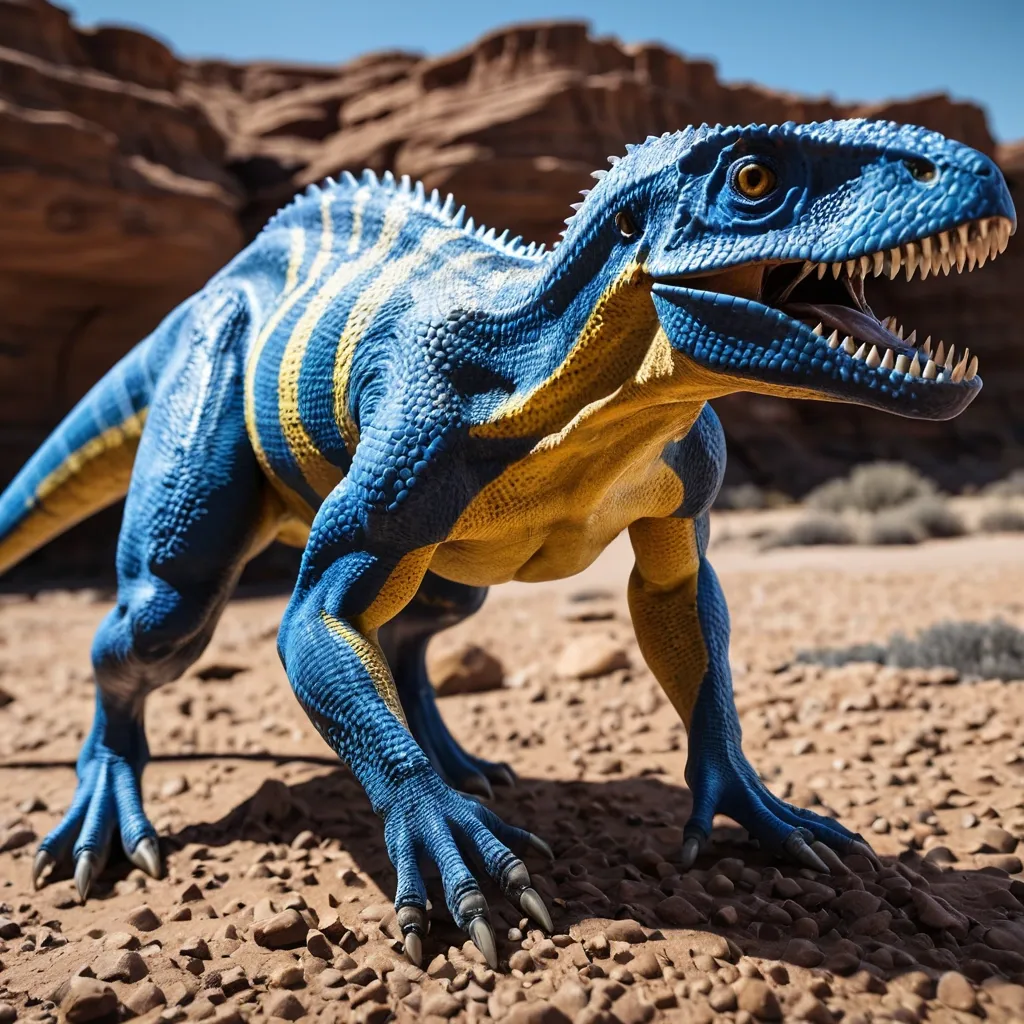
The hybrid was created by modifying the genome of a Tyrannosaurus rex , with the DNA of three other theropod species that were Utahraptor , Saurophaganax , and Giganotosaurus. Also the DNA of Quadrupes like Triceratops , and Scelidosaurus. DNA of modern animals such as Greater blue-ringed octopus , Inland Taipan , Northern Short-tailed Shrew , Komodo Dragon , Opossum , Mongoose , Gigantopithecus , Whiptail Lizard , Cuttlefish , and Tardigrades. The genome of Tyrannosaurus rex , Triceratops and Giganotosaurus was used as the base genome for the hybrid. Including the shape of the head in some parts from Giganotosaurus and Triceratops. Utahraptor DNA was added for high levels of intelligence and the ability to make plans , decisions and pack hunting. Reduced hind legs and Ape DNA added Knuckle-walking Quadruped. Triceratops , and Scelidosaurus were added to act as a biological form of armor that absorbed most of the incoming attacks. Northern short-tailed shrew , the Inland taipan's retractable fangs and the Komodo Dragon DNA was used to form the teeth of the Indominus that were used to tear through the flesh and armor of opponents. Saurophaganax and Gigantopithecus DNA added the presence of long strong arms with slashing hook claws and the use of tools. A swipe of the hybrid's claws would take down bigger opponents. While using tools for smaller elusive prey. Cuttlefish genes were intended to help the Venenosus withstand an accelerated growth , but it also added chromatophore cells in the skin so it could change the shape , color , and texture of its skin like a cuttlefish. Opossum , Mongoose and Tardigrades DNA was added for the Venenosus to be more resistant to climate changes , harmful toxins or bacterial infections , while tardigrades also added survival of extreme conditions such as exposure to extreme temperatures , extreme pressures , air deprivation , radiation , dehydration , and starvation. They have several defense mechanisms , including: A metabolic rate that gets as low as 0.01 percent of the normal rate. Organs protected by a sugary gel called trehalose. A protein that shields their DNA from radiation harm. Synthesis of cryoprotectant in chilly temperatures to prevent the development of ice crystals.Northern short-tailed shrew , the Inland Taipan , Greater blue-ringed octopus and the Komodo Dragon's DNA also added special cavities and glands in the skull that gave her infrared vision , and highly toxic saliva. Said DNA also gave her the ability to open her mandibles and jaws as wide as a snake , specifically at around 90 degrees.Lastly , DNA from a whiptail lizard was added for reproduction purposes. ,
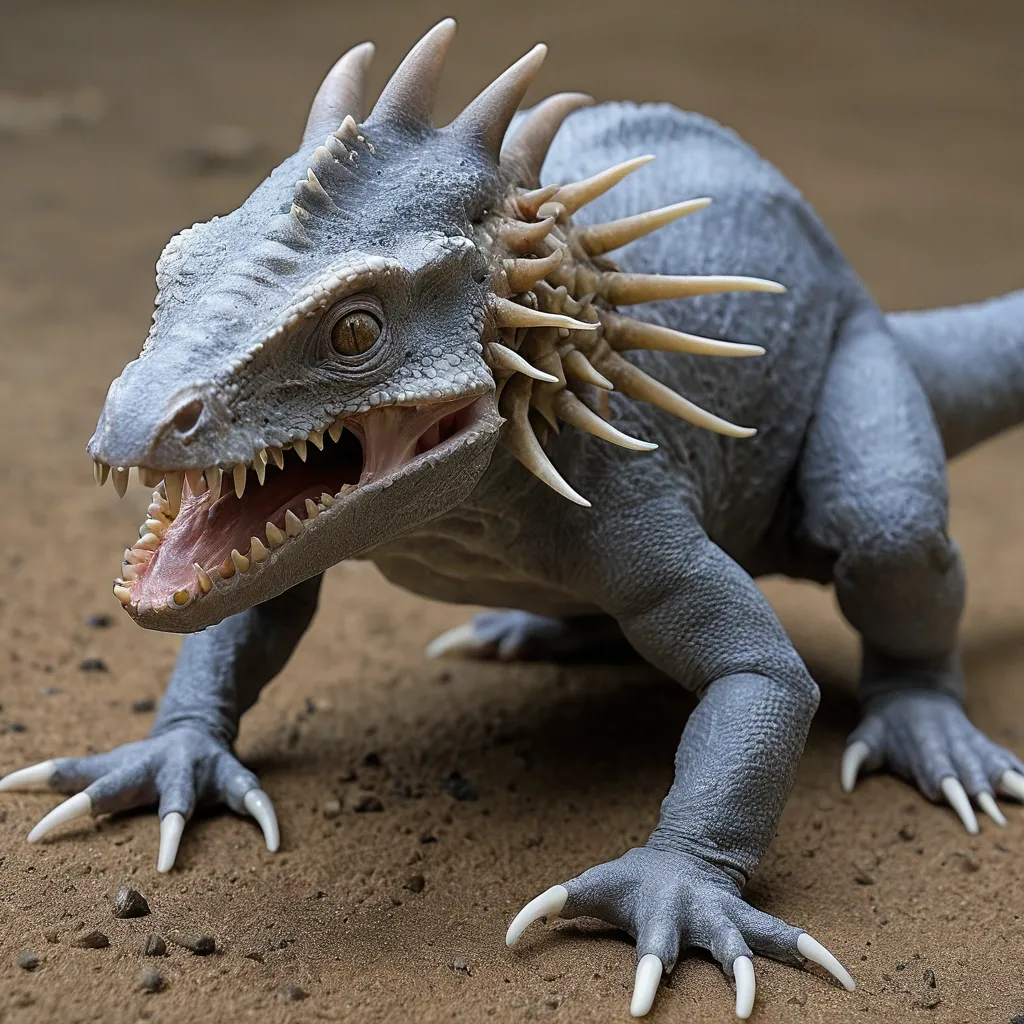
The genome of Tyrannosaurus rex , Triceratops and Giganotosaurus was used as the base genome for the hybrid. Including the shape of the head in some parts from Triceratops. Utahraptor DNA was added for high levels of intelligence and the ability to make plans , decisions and pack hunting. Reduced hind legs and Ape DNA added Knuckle-walking Quadruped. Triceratops , and Scelidosaurus were added to act as a biological form of armor that absorbed most of the incoming attacks. Northern short-tailed shrew , the Inland taipan's retractable fangs and the Komodo Dragon DNA was used to form the teeth of the Indominus that were used to tear through the flesh and armor of opponents. Saurophaganax and Gigantopithecus DNA added the presence of long strong arms with slashing hook claws and the use of tools. A swipe of the hybrid's claws would take down bigger opponents. While using tools for smaller elusive prey. Cuttlefish genes were intended to help the Venenosus withstand an accelerated growth , but it also added chromatophore cells in the skin so it could change the shape , color , and texture of its skin like a cuttlefish. Opossum , Mongoose and Tardigrades DNA was added for the Venenosus to be more resistant to climate changes , harmful toxins or bacterial infections , while tardigrades also added survival of extreme conditions such as exposure to extreme temperatures , extreme pressures , air deprivation , radiation , dehydration , and starvation. They have several defense mechanisms , including: A metabolic rate that gets as low as 0.01 percent of the normal rate. Organs protected by a sugary gel called trehalose. A protein that shields their DNA from radiation harm. Synthesis of cryoprotectant in chilly temperatures to prevent the development of ice crystals.Northern short-tailed shrew , the Inland Taipan , Greater blue-ringed octopus and the Komodo Dragon's DNA also added special cavities and glands in the skull that gave her infrared vision , and highly toxic saliva. Said DNA also gave her the ability to open her mandibles and jaws as wide as a snake , specifically at around 90 degrees.Lastly , DNA from a whiptail lizard was added for reproduction purposes. ,
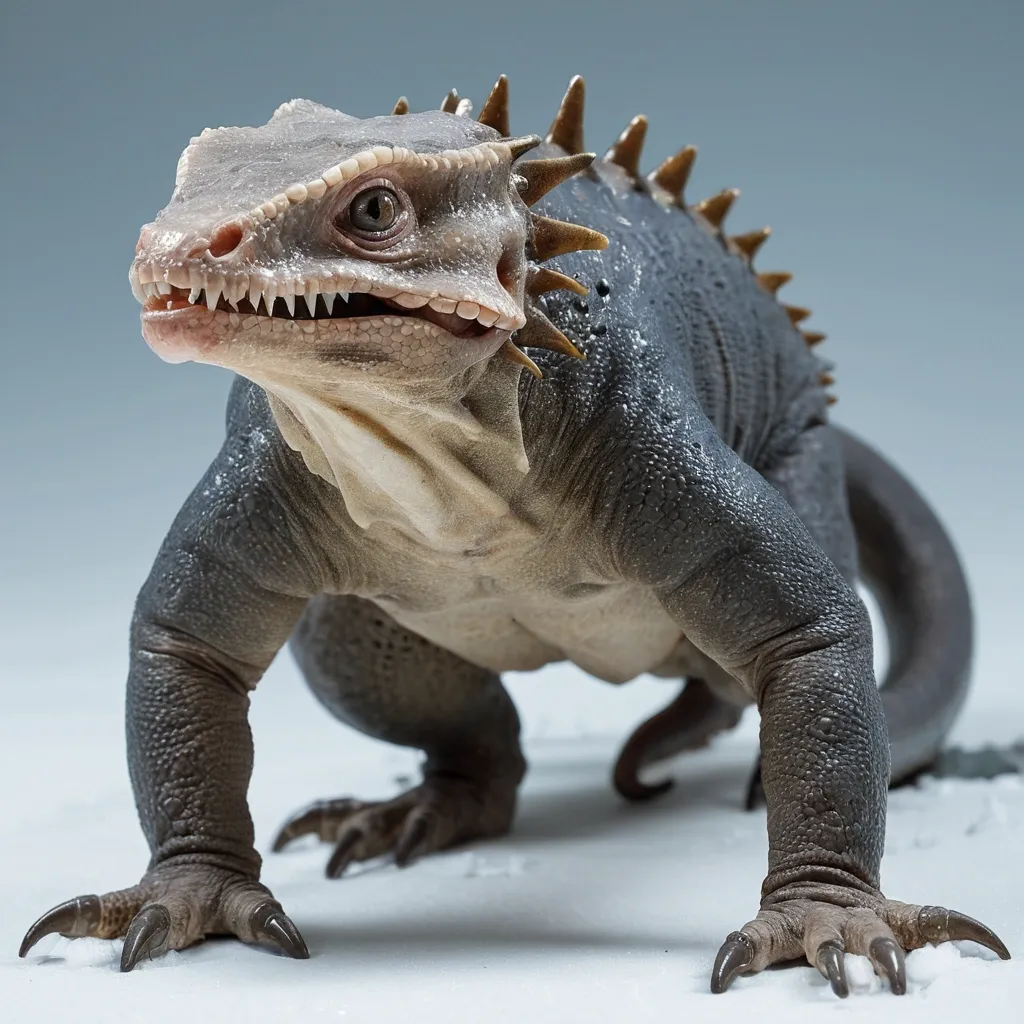
The genome of Tyrannosaurus rex , Triceratops and Giganotosaurus was used as the base genome for the hybrid. Including the shape of the head in some parts from Triceratops. Utahraptor DNA was added for high levels of intelligence and the ability to make plans , decisions and pack hunting. Reduced hind legs and Ape DNA added Knuckle-walking Quadruped. Triceratops , and Scelidosaurus were added to act as a biological form of armor that absorbed most of the incoming attacks. Northern short-tailed shrew , the Inland taipan's retractable fangs and the Komodo Dragon DNA was used to form the teeth of the Indominus that were used to tear through the flesh and armor of opponents. Saurophaganax and Gigantopithecus DNA added the presence of long strong arms with slashing hook claws and the use of tools. A swipe of the hybrid's claws would take down bigger opponents. While using tools for smaller elusive prey. Cuttlefish genes were intended to help the Venenosus withstand an accelerated growth , but it also added chromatophore cells in the skin so it could change the shape , color , and texture of its skin like a cuttlefish. Opossum , Mongoose and Tardigrades DNA was added for the Venenosus to be more resistant to climate changes , harmful toxins or bacterial infections , while tardigrades also added survival of extreme conditions such as exposure to extreme temperatures , extreme pressures , air deprivation , radiation , dehydration , and starvation. They have several defense mechanisms , including: A metabolic rate that gets as low as 0.01 percent of the normal rate. Organs protected by a sugary gel called trehalose. A protein that shields their DNA from radiation harm. Synthesis of cryoprotectant in chilly temperatures to prevent the development of ice crystals.Northern short-tailed shrew , the Inland Taipan , Greater blue-ringed octopus and the Komodo Dragon's DNA also added special cavities and glands in the skull that gave her infrared vision , and highly toxic saliva. Said DNA also gave her the ability to open her mandibles and jaws as wide as a snake , specifically at around 90 degrees.Lastly , DNA from a whiptail lizard was added for reproduction purposes. ,
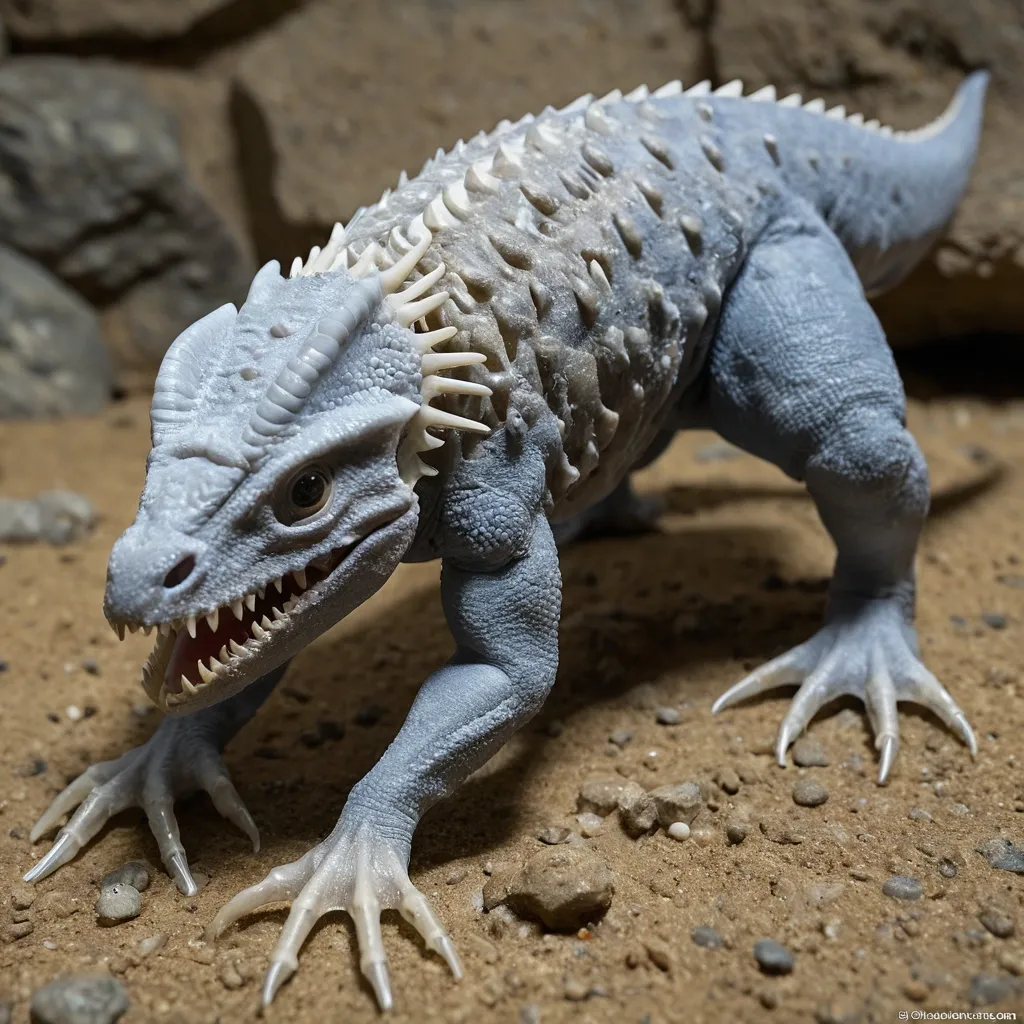
The genome of Tyrannosaurus rex , Triceratops and Giganotosaurus was used as the base genome for the hybrid. Including the shape of the head in some parts from Triceratops. Utahraptor DNA was added for high levels of intelligence and the ability to make plans , decisions and pack hunting. Reduced hind legs and Ape DNA added Knuckle-walking Quadruped. Triceratops , and Scelidosaurus were added to act as a biological form of armor that absorbed most of the incoming attacks. Northern short-tailed shrew , the Inland taipan's retractable fangs and the Komodo Dragon DNA was used to form the teeth of the Indominus that were used to tear through the flesh and armor of opponents. Saurophaganax and Gigantopithecus DNA added the presence of long strong arms with slashing hook claws and the use of tools. A swipe of the hybrid's claws would take down bigger opponents. While using tools for smaller elusive prey. Cuttlefish genes were intended to help the Venenosus withstand an accelerated growth , but it also added chromatophore cells in the skin so it could change the shape , color , and texture of its skin like a cuttlefish. Opossum , Mongoose and Tardigrades DNA was added for the Venenosus to be more resistant to climate changes , harmful toxins or bacterial infections , while tardigrades also added survival of extreme conditions such as exposure to extreme temperatures , extreme pressures , air deprivation , radiation , dehydration , and starvation. They have several defense mechanisms , including: A metabolic rate that gets as low as 0.01 percent of the normal rate. Organs protected by a sugary gel called trehalose. A protein that shields their DNA from radiation harm. Synthesis of cryoprotectant in chilly temperatures to prevent the development of ice crystals.Northern short-tailed shrew , the Inland Taipan , Greater blue-ringed octopus and the Komodo Dragon's DNA also added special cavities and glands in the skull that gave her infrared vision , and highly toxic saliva. Said DNA also gave her the ability to open her mandibles and jaws as wide as a snake , specifically at around 90 degrees.Lastly , DNA from a whiptail lizard was added for reproduction purposes. ,
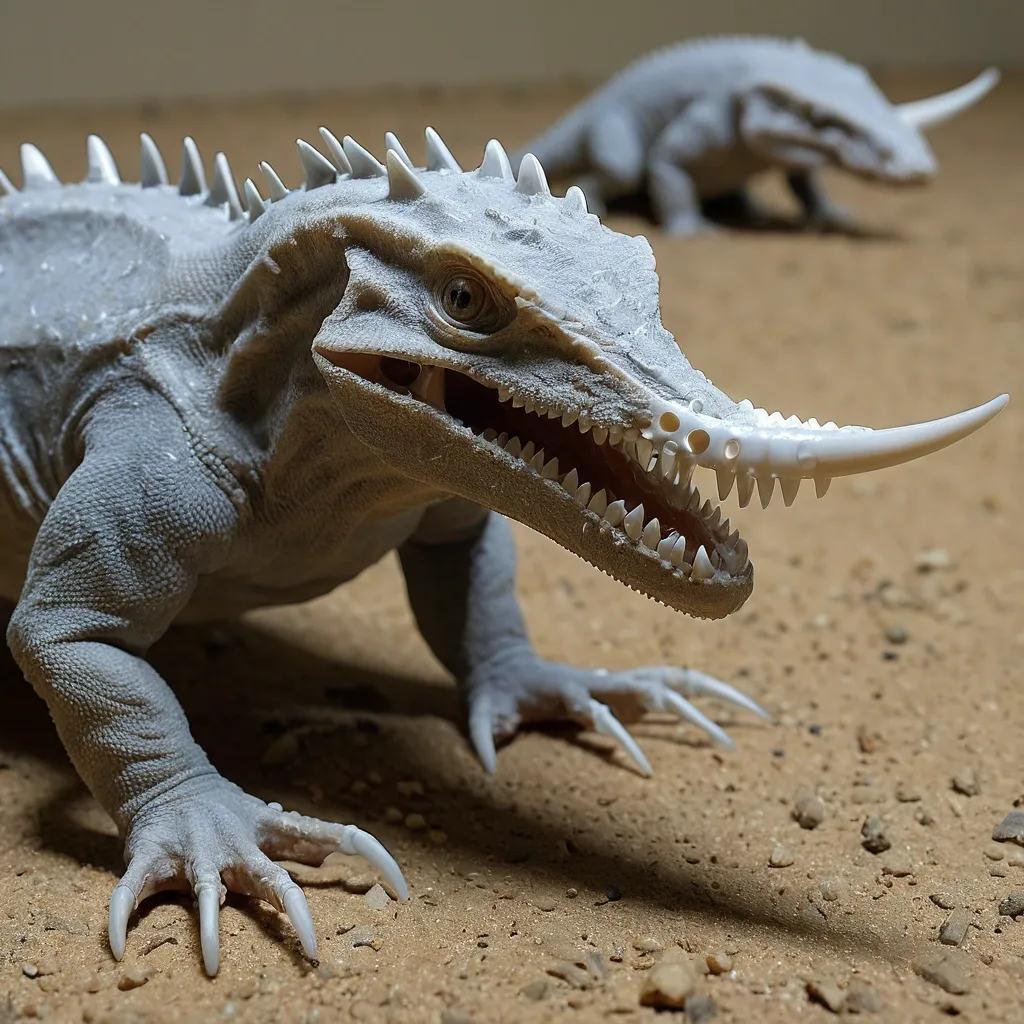
The genome of Tyrannosaurus rex , Triceratops and Giganotosaurus was used as the base genome for the hybrid. Including the shape of the head in some parts from Triceratops. Utahraptor DNA was added for high levels of intelligence and the ability to make plans , decisions and pack hunting. Reduced hind legs and Ape DNA added Knuckle-walking Quadruped. Triceratops , and Scelidosaurus were added to act as a biological form of armor that absorbed most of the incoming attacks. Northern short-tailed shrew , the Inland taipan's retractable fangs and the Komodo Dragon DNA was used to form the teeth of the Indominus that were used to tear through the flesh and armor of opponents. Saurophaganax and Gigantopithecus DNA added the presence of long strong arms with slashing hook claws and the use of tools. A swipe of the hybrid's claws would take down bigger opponents. While using tools for smaller elusive prey. Cuttlefish genes were intended to help the Venenosus withstand an accelerated growth , but it also added chromatophore cells in the skin so it could change the shape , color , and texture of its skin like a cuttlefish. Opossum , Mongoose and Tardigrades DNA was added for the Venenosus to be more resistant to climate changes , harmful toxins or bacterial infections , while tardigrades also added survival of extreme conditions such as exposure to extreme temperatures , extreme pressures , air deprivation , radiation , dehydration , and starvation. They have several defense mechanisms , including: A metabolic rate that gets as low as 0.01 percent of the normal rate. Organs protected by a sugary gel called trehalose. A protein that shields their DNA from radiation harm. Synthesis of cryoprotectant in chilly temperatures to prevent the development of ice crystals.Northern short-tailed shrew , the Inland Taipan , Greater blue-ringed octopus and the Komodo Dragon's DNA also added special cavities and glands in the skull that gave her infrared vision , and highly toxic saliva. Said DNA also gave her the ability to open her mandibles and jaws as wide as a snake , specifically at around 90 degrees.Lastly , DNA from a whiptail lizard was added for reproduction purposes. ,
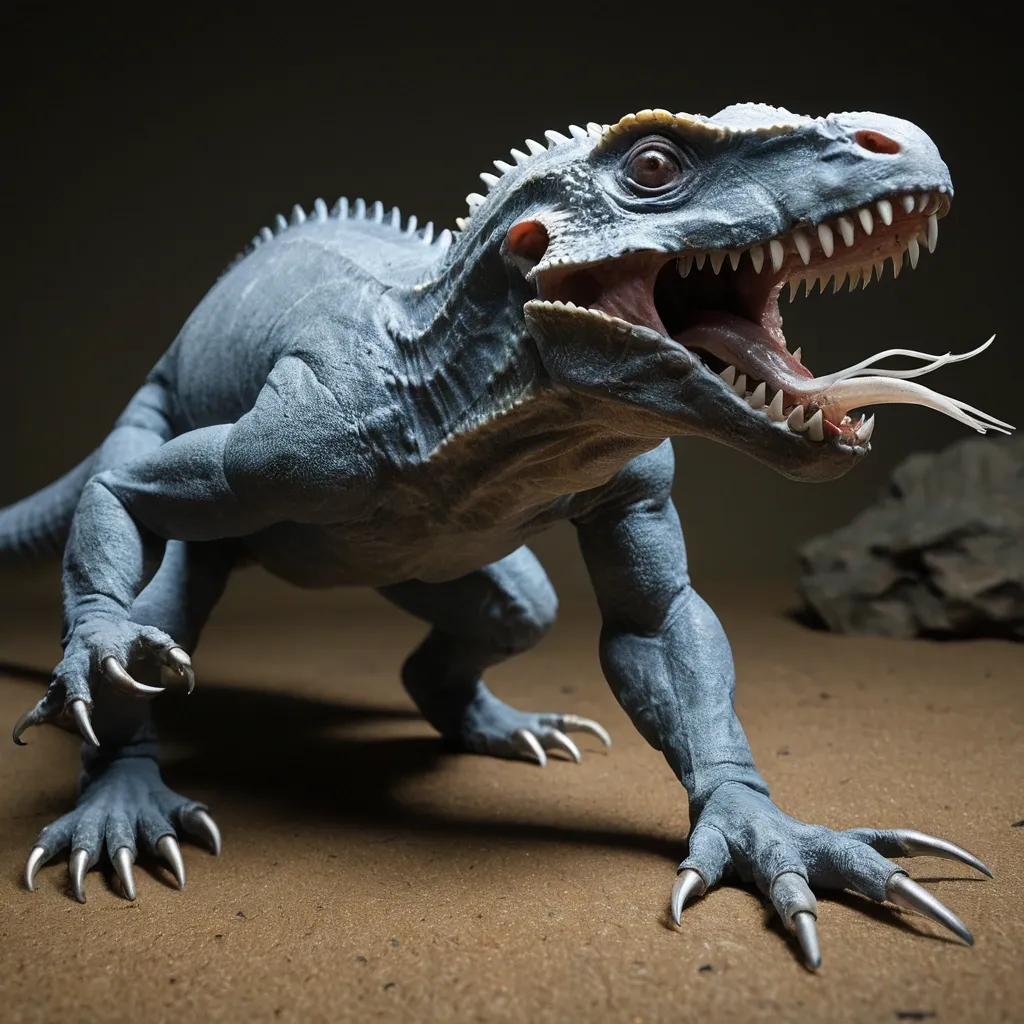
The genome of Tyrannosaurus rex , Triceratops and Giganotosaurus was used as the base genome for the hybrid. Including the shape of the head in some parts from Giganotosaurus and Triceratops. It also gave the Indominus rex an incredibly strong bite that could crush bulletproof glass. Utahraptor DNA was added for high levels of intelligence and the ability to make plans , decisions and pack hunting. Reduced hind legs and Ape DNA added Knuckle-walking Quadruped. Triceratops , and Scelidosaurus were added to act as a biological form of armor that absorbed most of the incoming attacks. Northern short-tailed shrew , the Inland taipan's retractable fangs and the Komodo Dragon DNA was used to form the teeth of the Indominus that were used to tear through the flesh and armor of opponents. Saurophaganax and Gigantopithecus DNA added the presence of long strong arms with slashing hook claws and the use of tools. A swipe of the hybrid's claws would take down bigger opponents. While using tools for smaller elusive prey. Cuttlefish genes were intended to help the Venenosus withstand an accelerated growth , but it also added chromatophore cells in the skin so it could change the shape , color , and texture of its skin like a cuttlefish. Opossum , Mongoose and Tardigrades DNA was added for the Venenosus to be more resistant to climate changes , harmful toxins or bacterial infections , while tardigrades also added survival of extreme conditions such as exposure to extreme temperatures , extreme pressures , air deprivation , radiation , dehydration , and starvation. They have several defense mechanisms , including: A metabolic rate that gets as low as 0.01 percent of the normal rate. Organs protected by a sugary gel called trehalose. A protein that shields their DNA from radiation harm. Synthesis of cryoprotectant in chilly temperatures to prevent the development of ice crystals.Northern short-tailed shrew , the Inland Taipan , Greater blue-ringed octopus and the Komodo Dragon's DNA also added special cavities and glands in the skull that gave her infrared vision , and highly toxic saliva. Said DNA also gave her the ability to open her mandibles and jaws as wide as a snake , specifically at around 90 degrees.Lastly , DNA from a whiptail lizard was added for reproduction purposes. ,
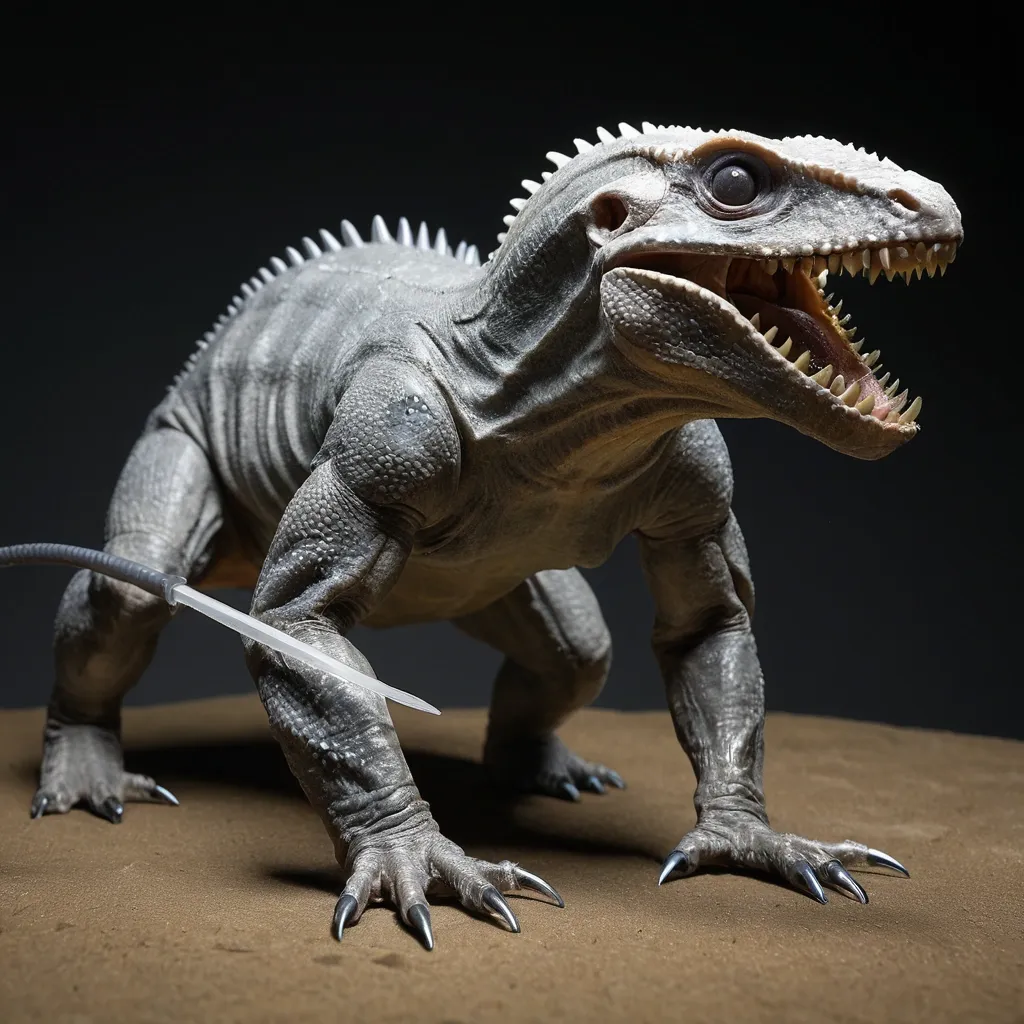
The genome of Tyrannosaurus rex , Triceratops and Giganotosaurus was used as the base genome for the hybrid. Including the shape of the head in some parts from Giganotosaurus and Triceratops. It also gave the Indominus rex an incredibly strong bite that could crush bulletproof glass. Utahraptor DNA was added for high levels of intelligence and the ability to make plans , decisions and pack hunting. Reduced hind legs and Ape DNA added Knuckle-walking Quadruped. Triceratops , and Scelidosaurus were added to act as a biological form of armor that absorbed most of the incoming attacks. Northern short-tailed shrew , the Inland taipan's retractable fangs and the Komodo Dragon DNA was used to form the teeth of the Indominus that were used to tear through the flesh and armor of opponents. Saurophaganax and Gigantopithecus DNA added the presence of long strong arms with slashing hook claws and the use of tools. A swipe of the hybrid's claws would take down bigger opponents. While using tools for smaller elusive prey. Cuttlefish genes were intended to help the Venenosus withstand an accelerated growth , but it also added chromatophore cells in the skin so it could change the shape , color , and texture of its skin like a cuttlefish. Opossum , Mongoose and Tardigrades DNA was added for the Venenosus to be more resistant to climate changes , harmful toxins or bacterial infections , while tardigrades also added survival of extreme conditions such as exposure to extreme temperatures , extreme pressures , air deprivation , radiation , dehydration , and starvation. They have several defense mechanisms , including: A metabolic rate that gets as low as 0.01 percent of the normal rate. Organs protected by a sugary gel called trehalose. A protein that shields their DNA from radiation harm. Synthesis of cryoprotectant in chilly temperatures to prevent the development of ice crystals.Northern short-tailed shrew , the Inland Taipan , Greater blue-ringed octopus and the Komodo Dragon's DNA also added special cavities and glands in the skull that gave her infrared vision , and highly toxic saliva. Said DNA also gave her the ability to open her mandibles and jaws as wide as a snake , specifically at around 90 degrees.Lastly , DNA from a whiptail lizard was added for reproduction purposes. ,